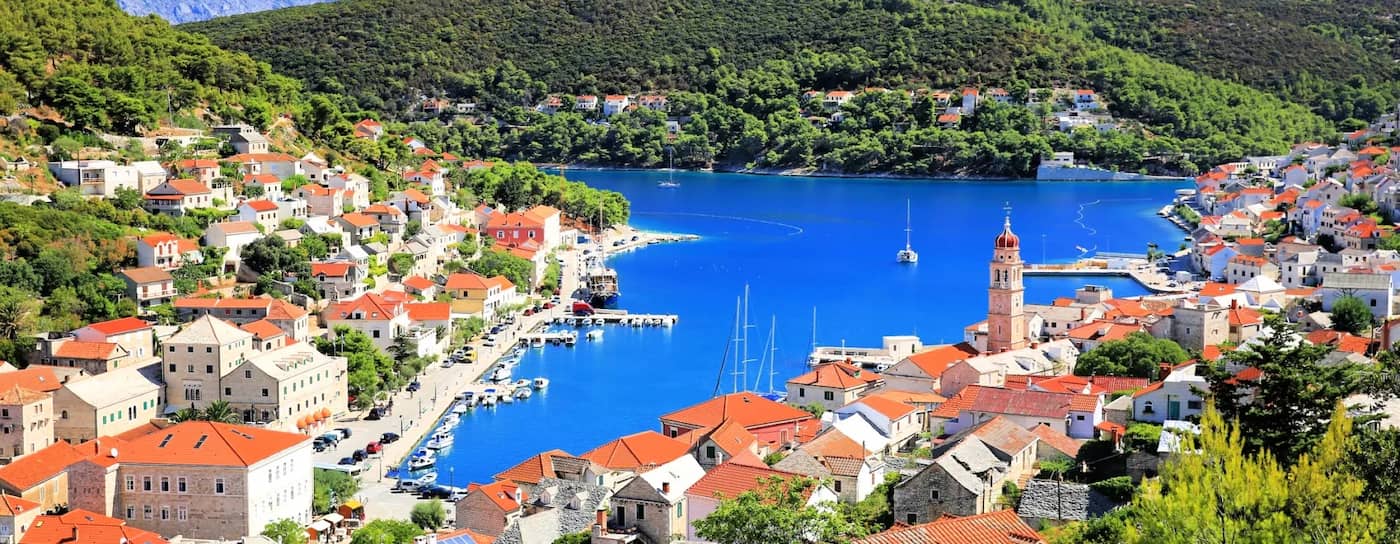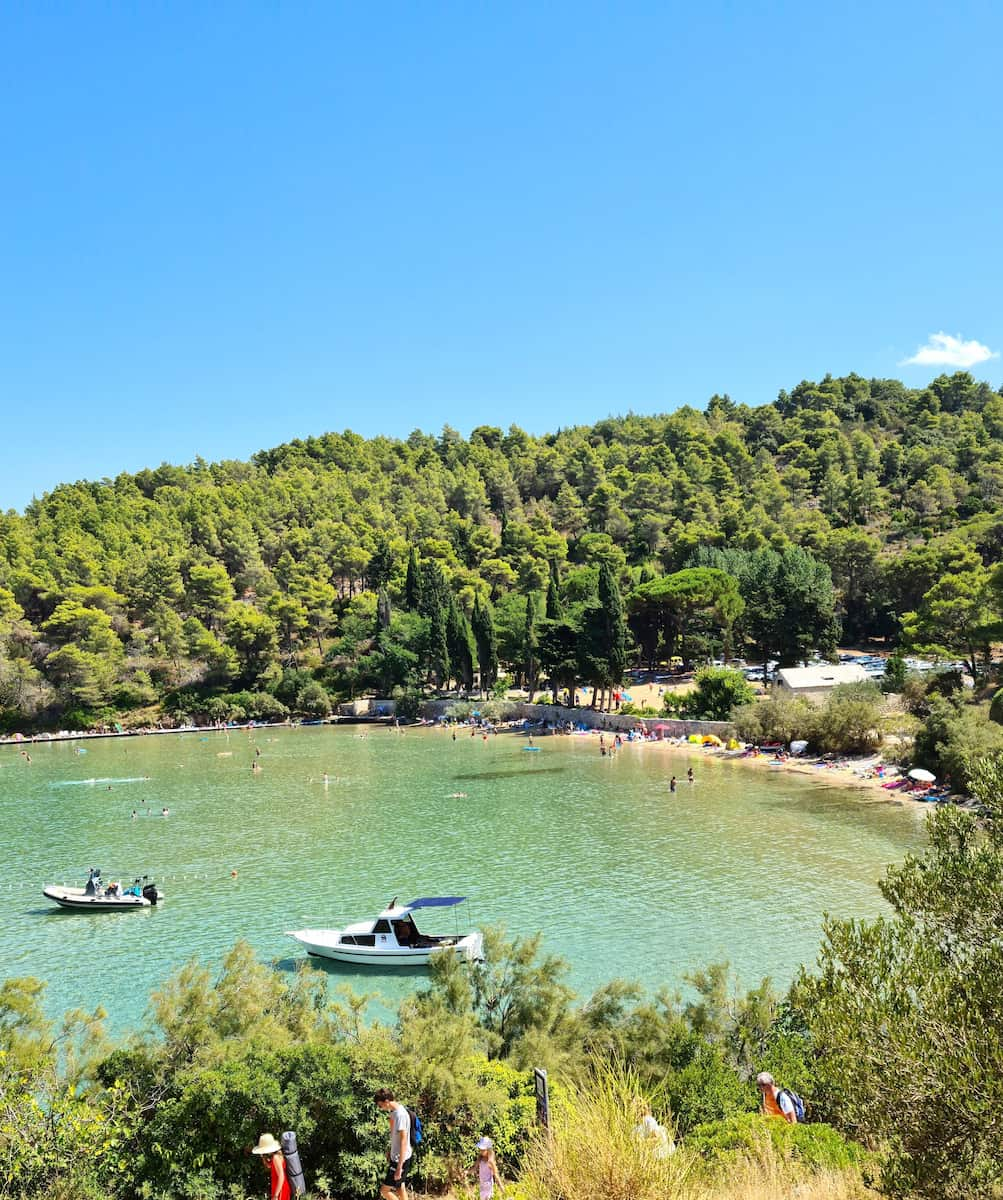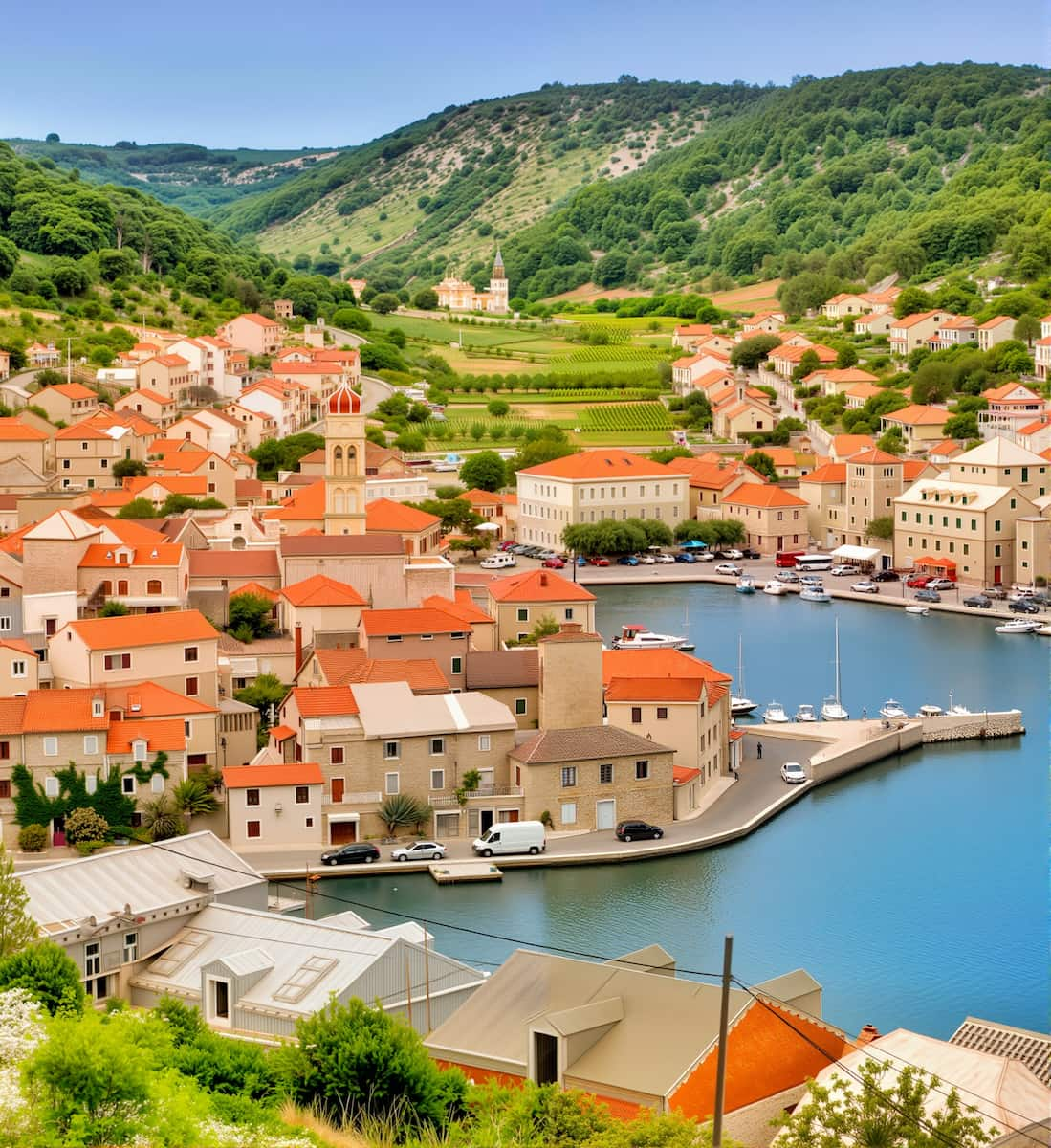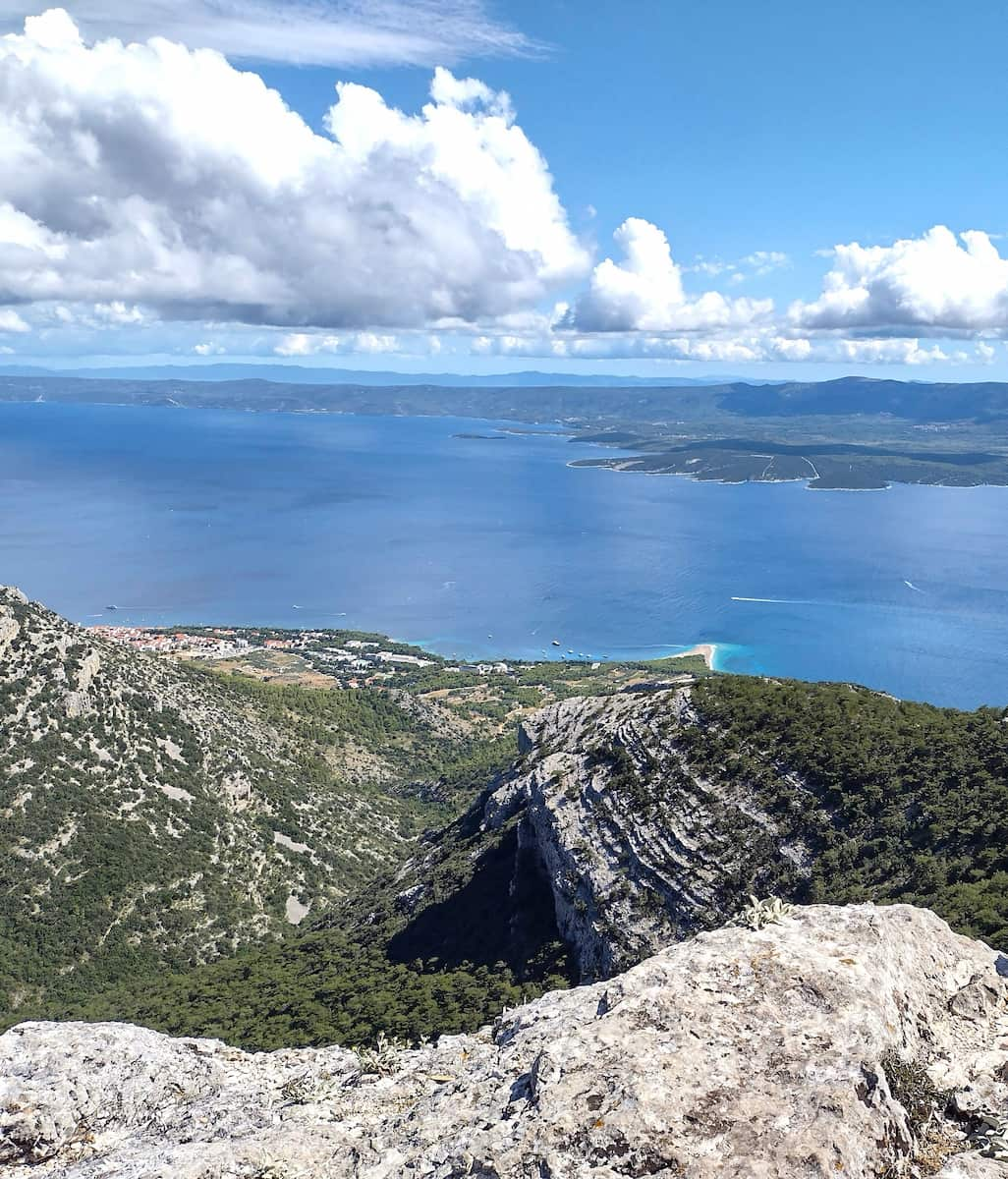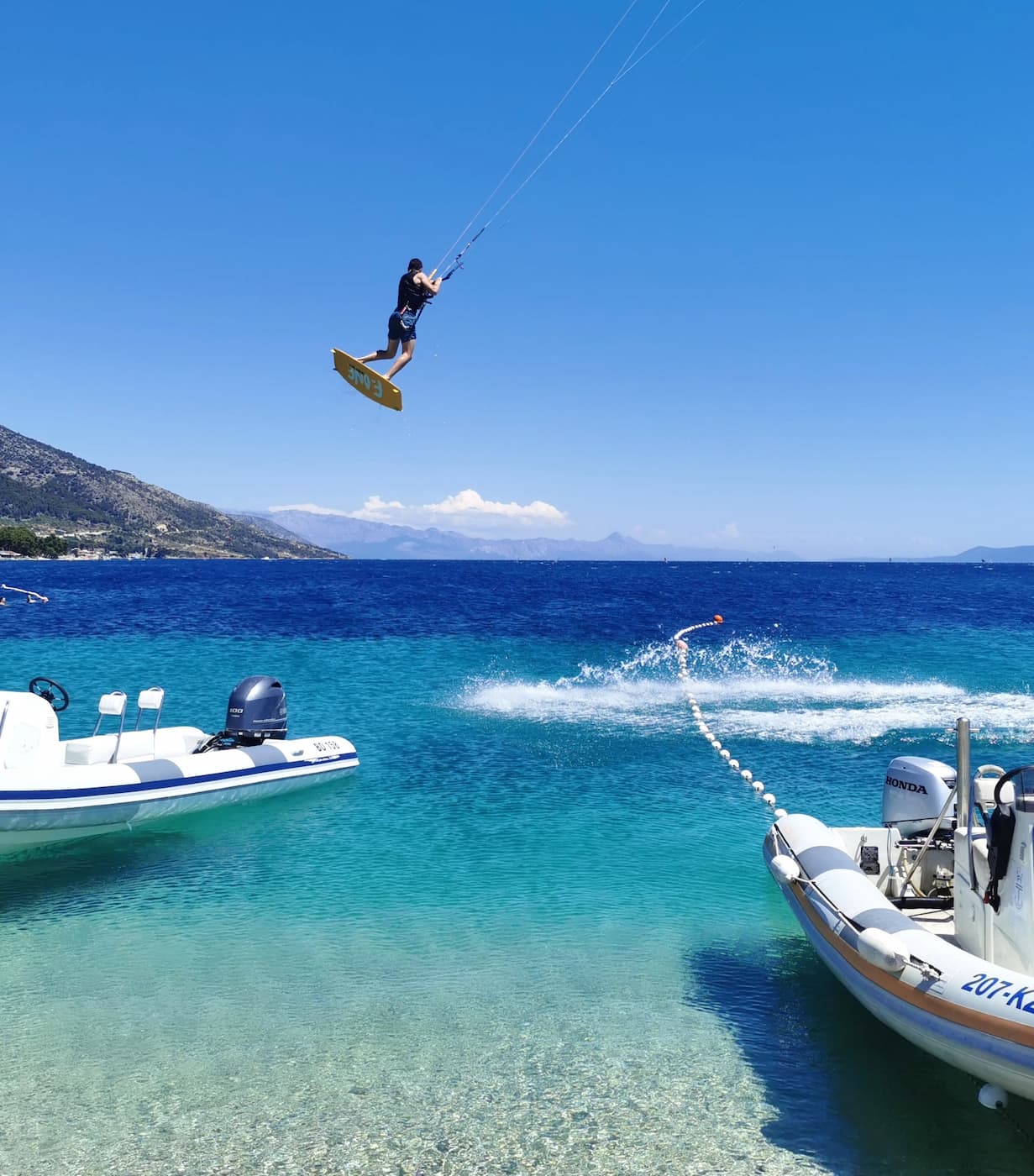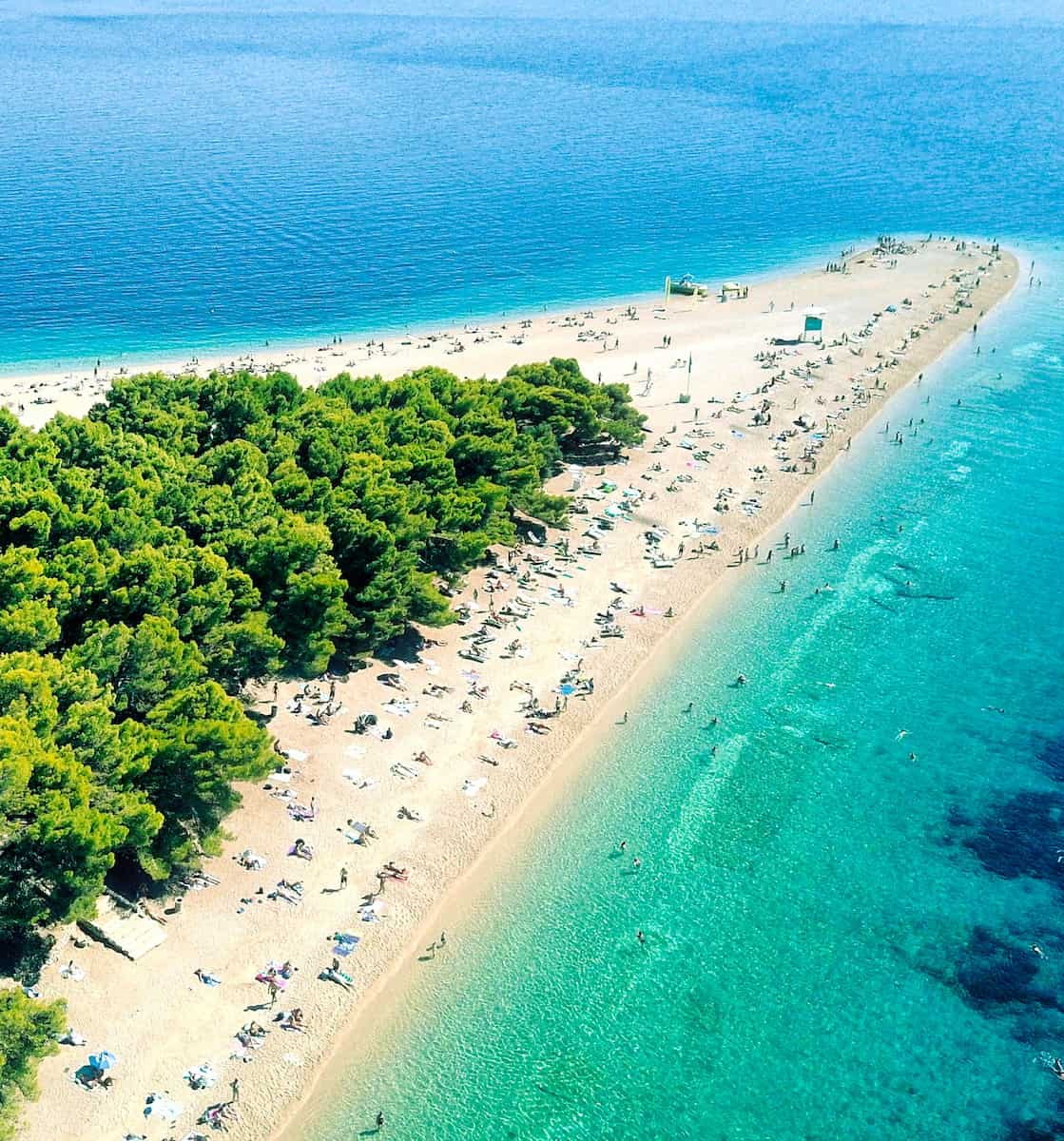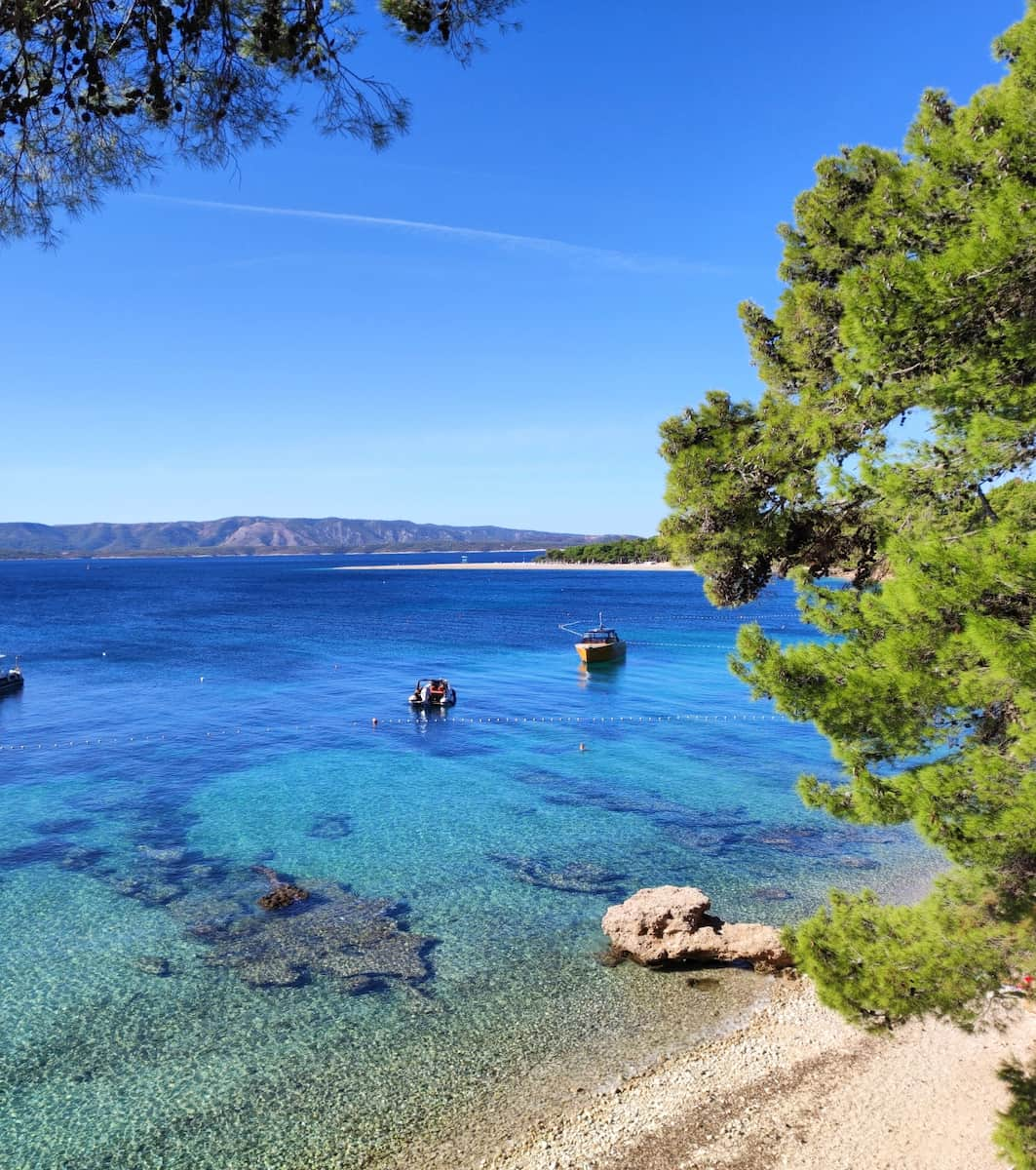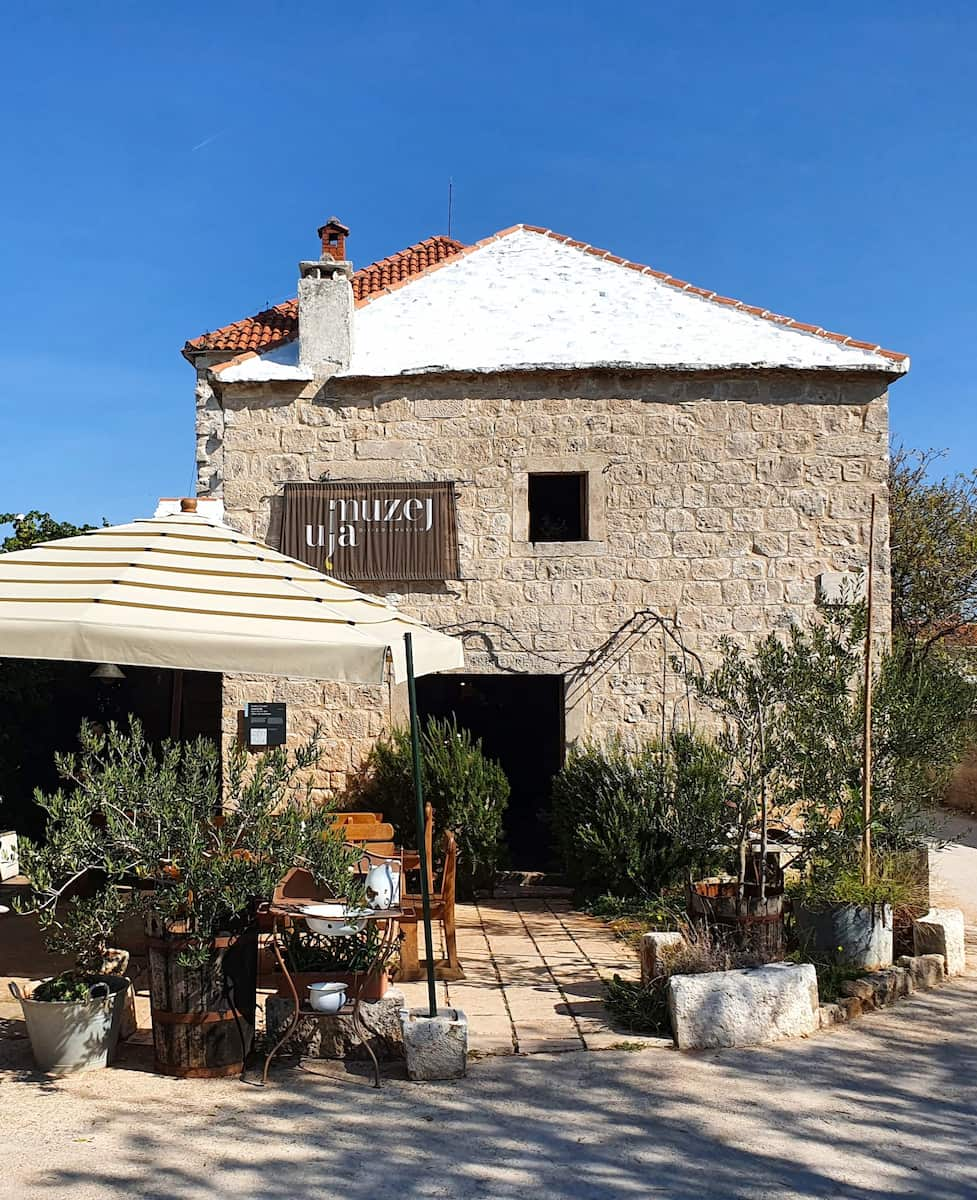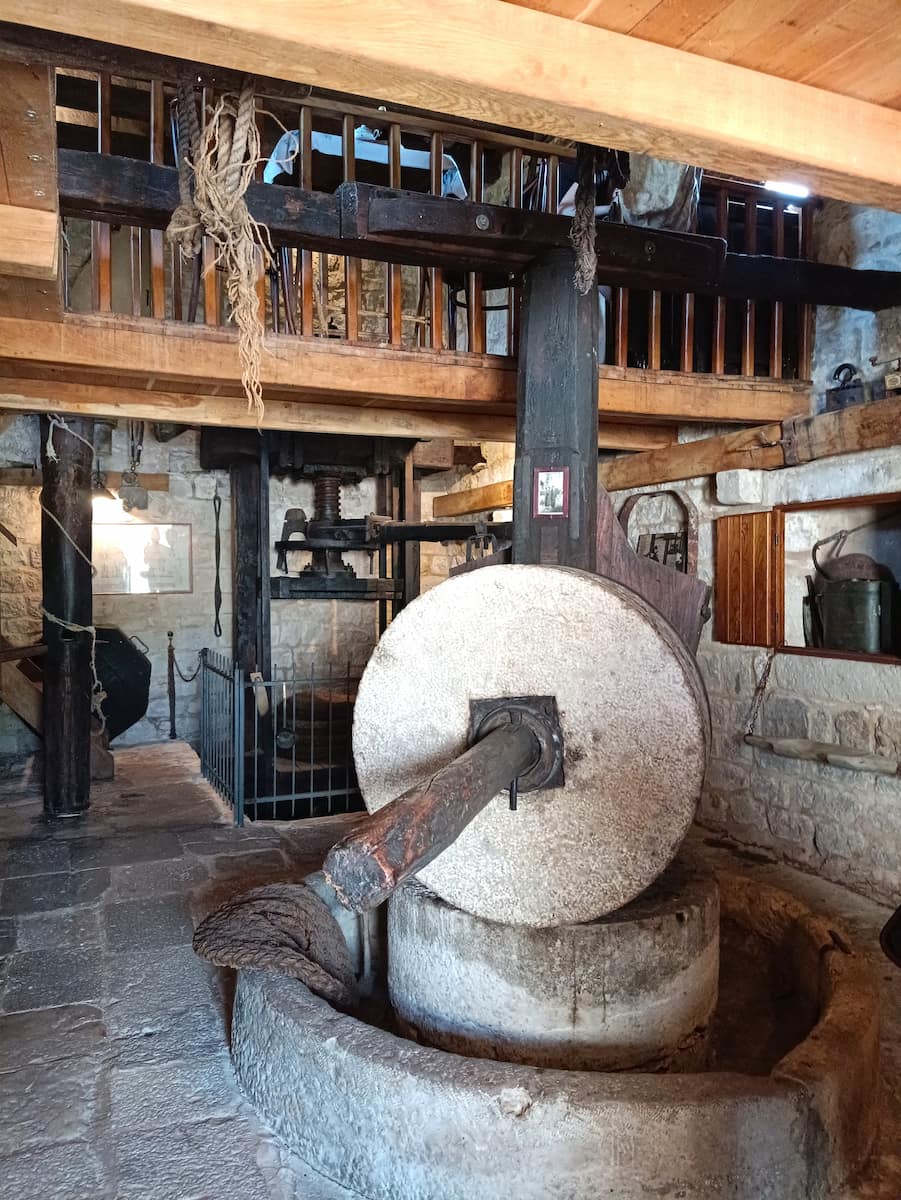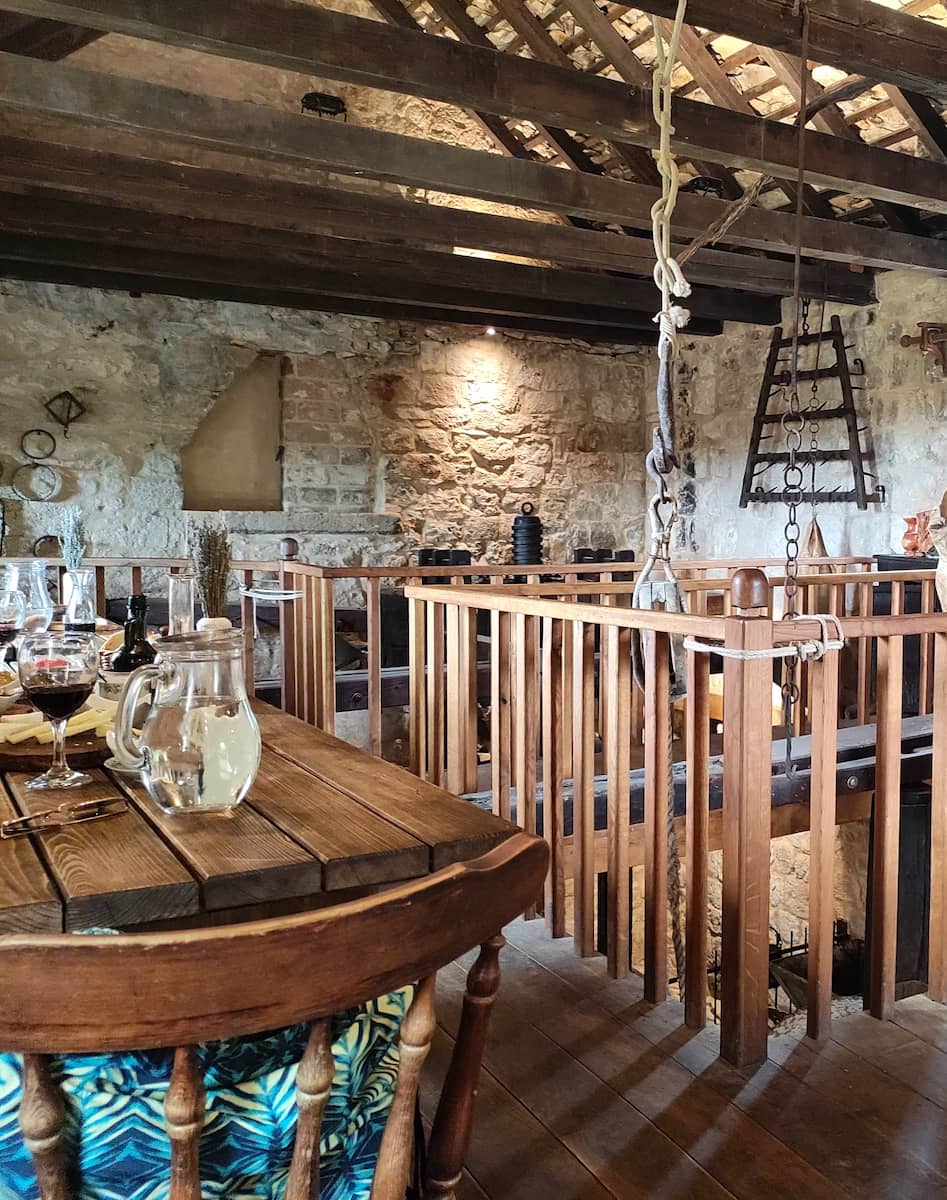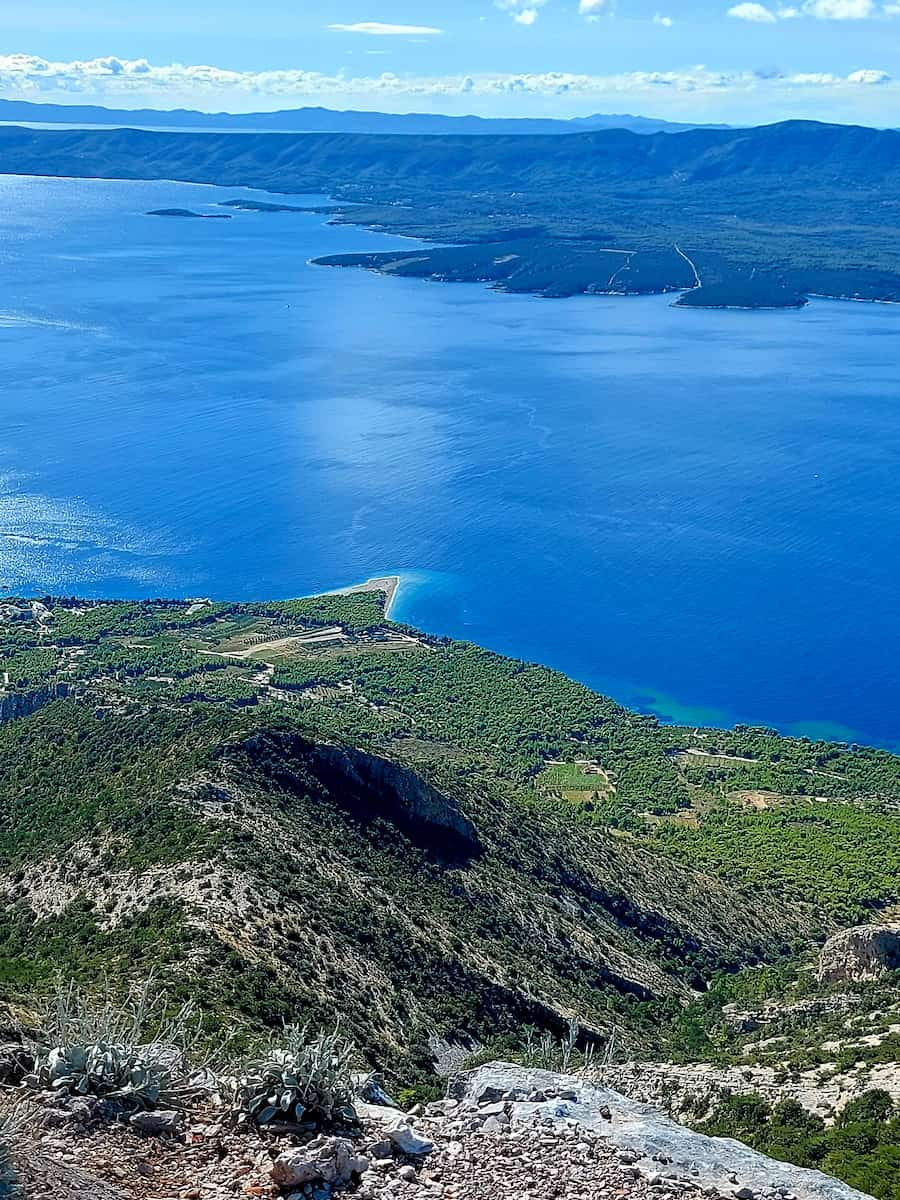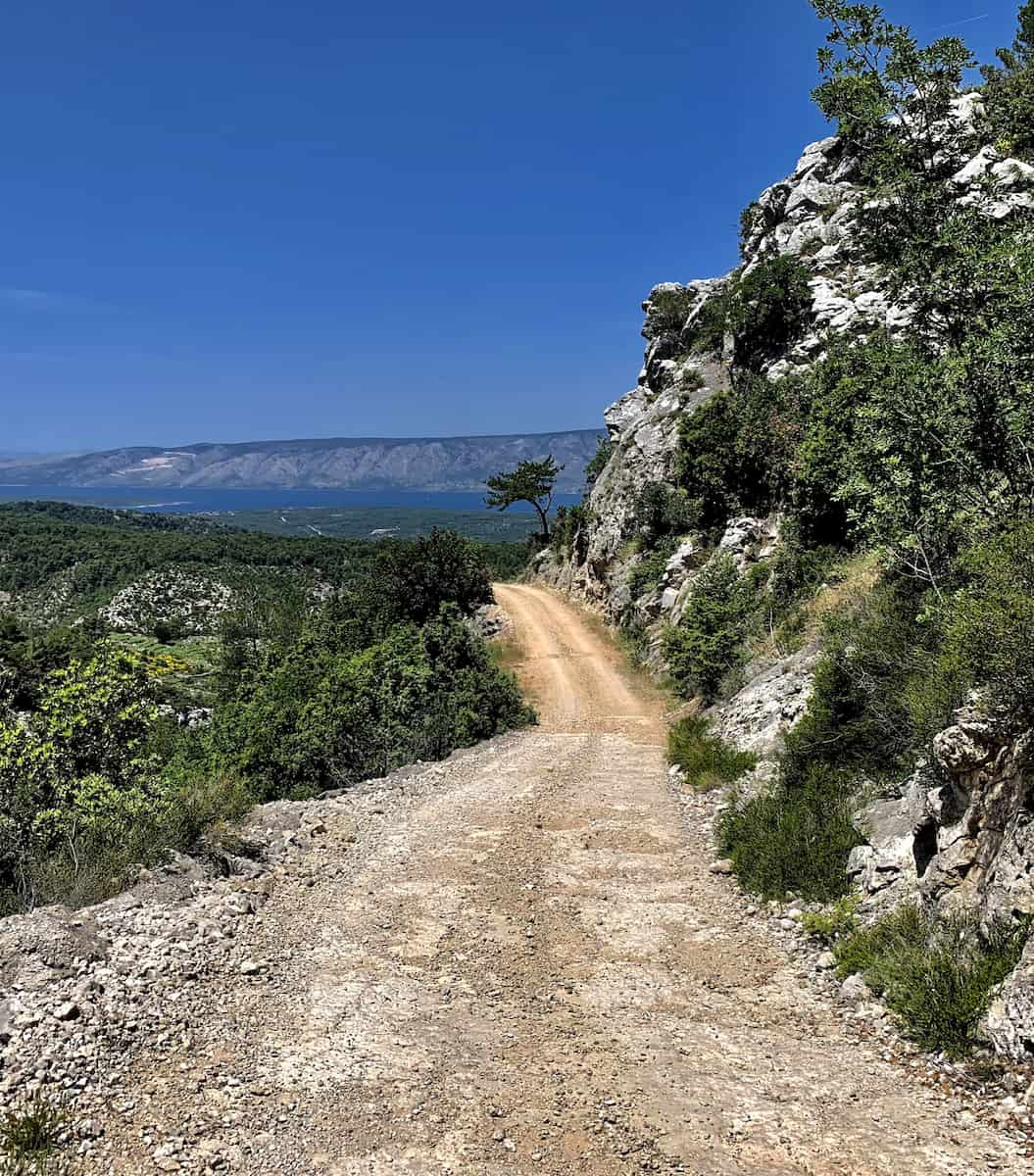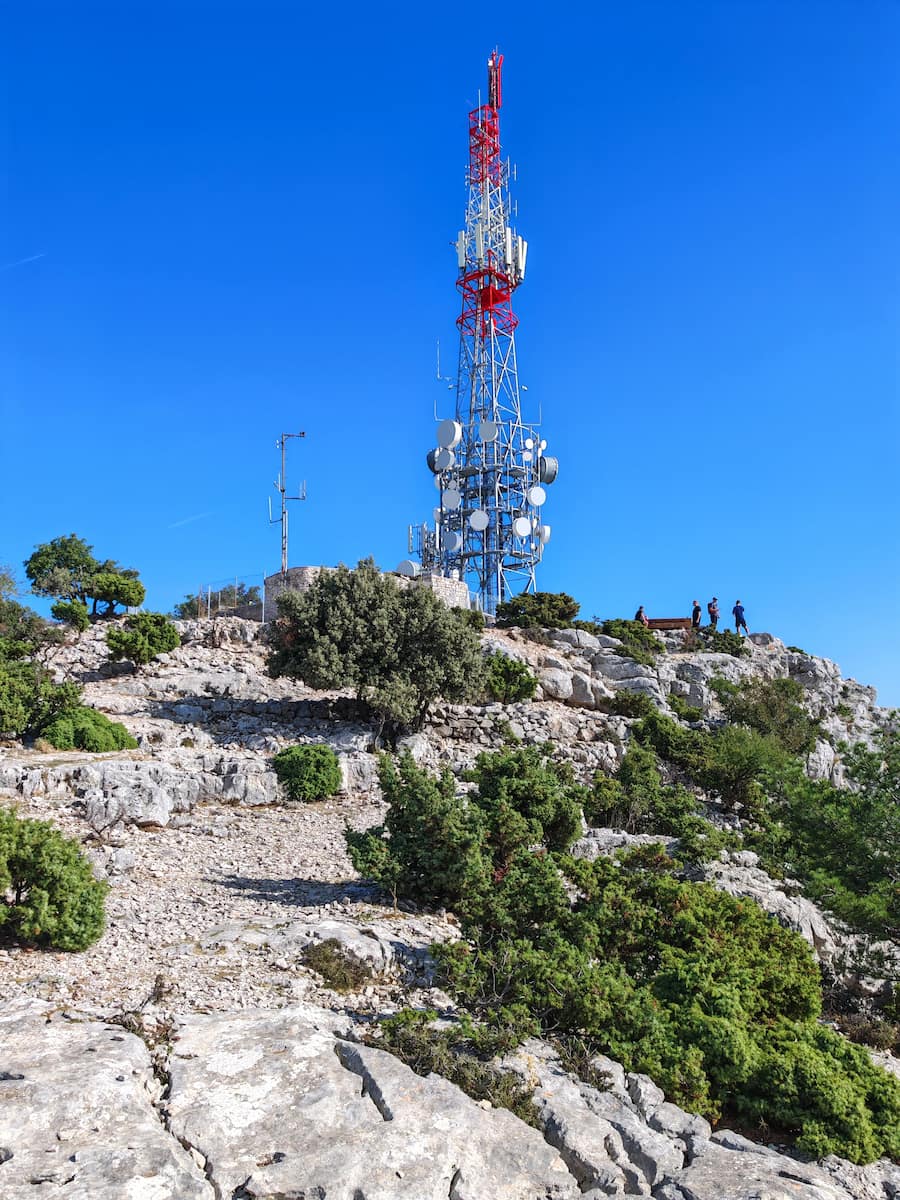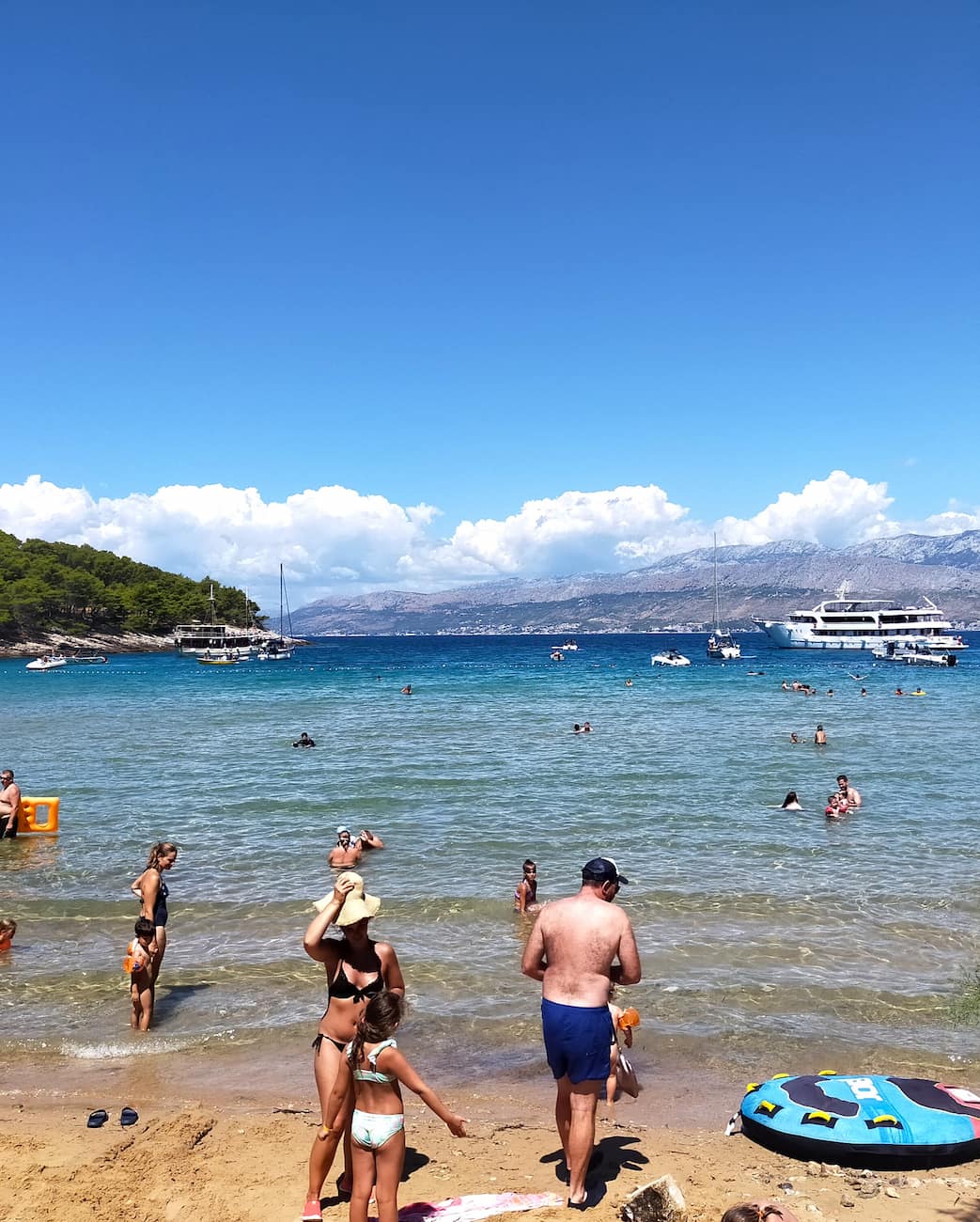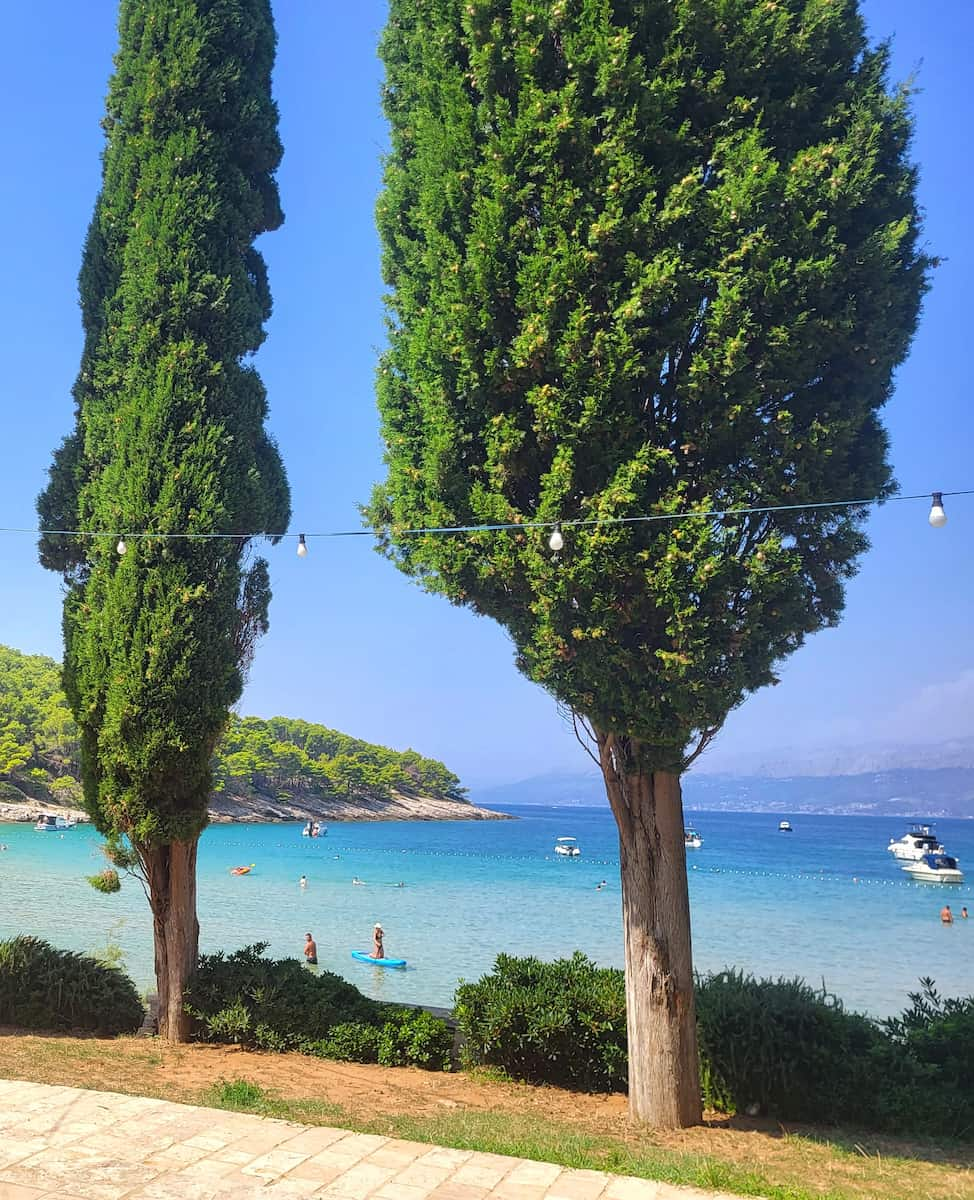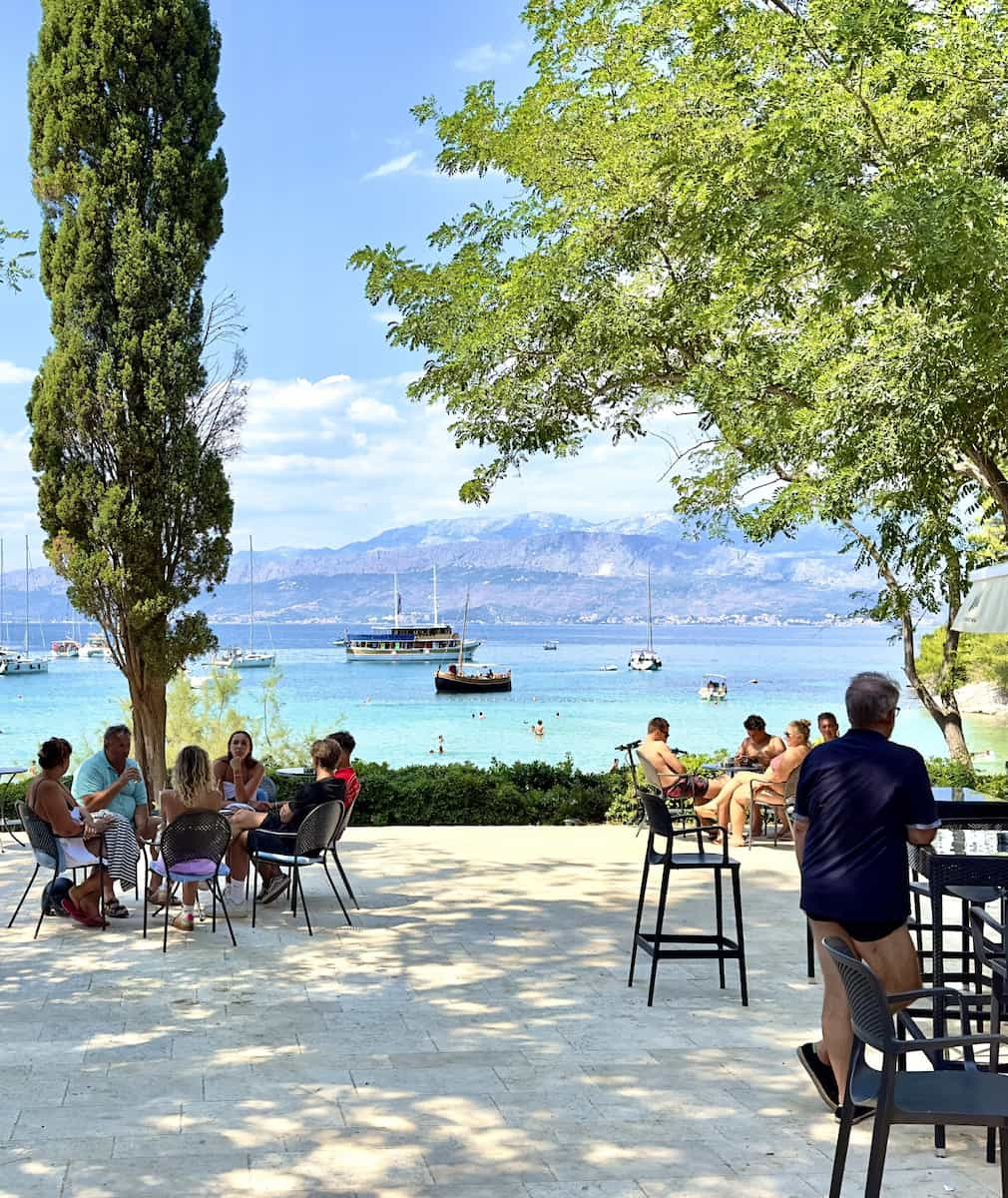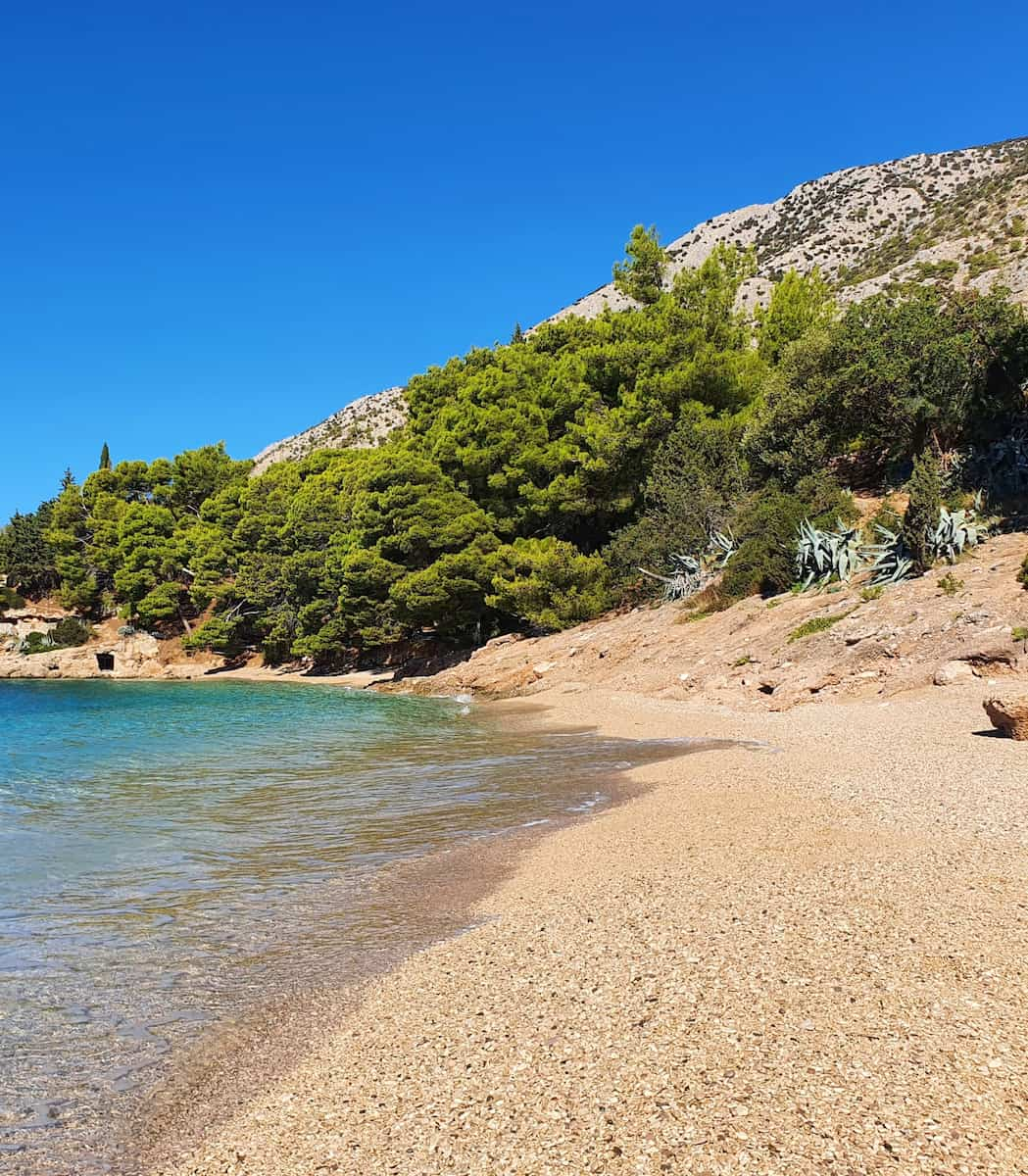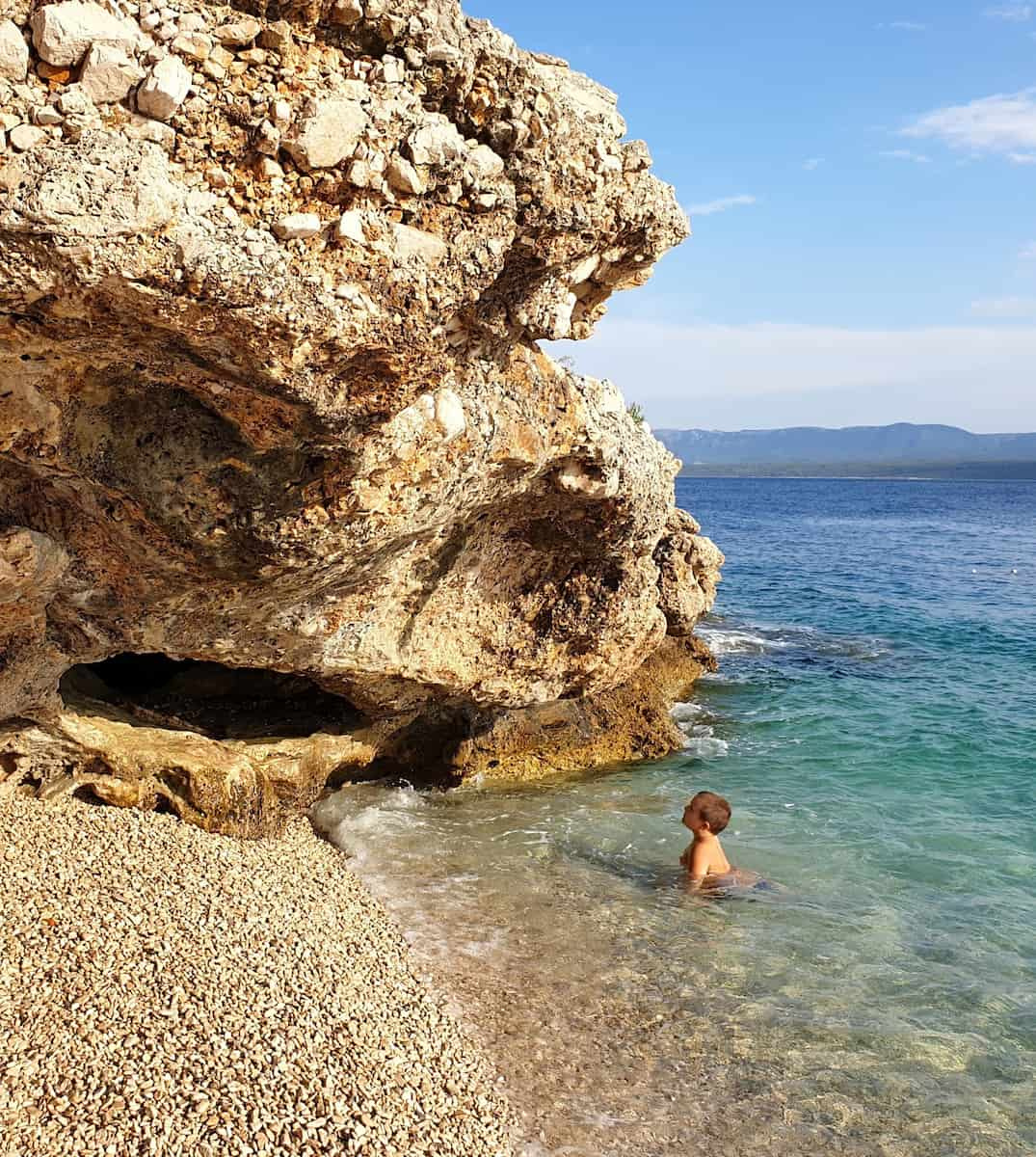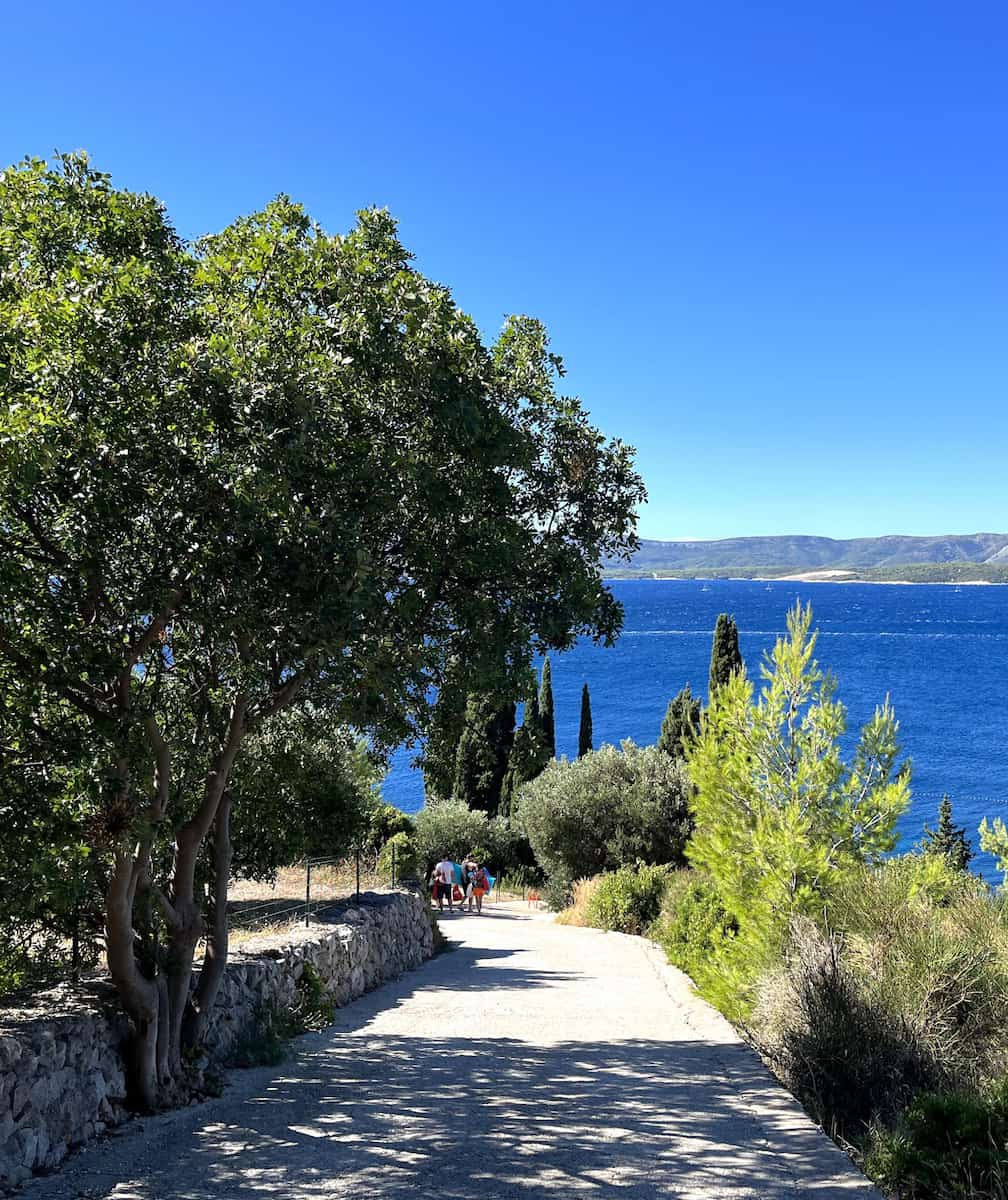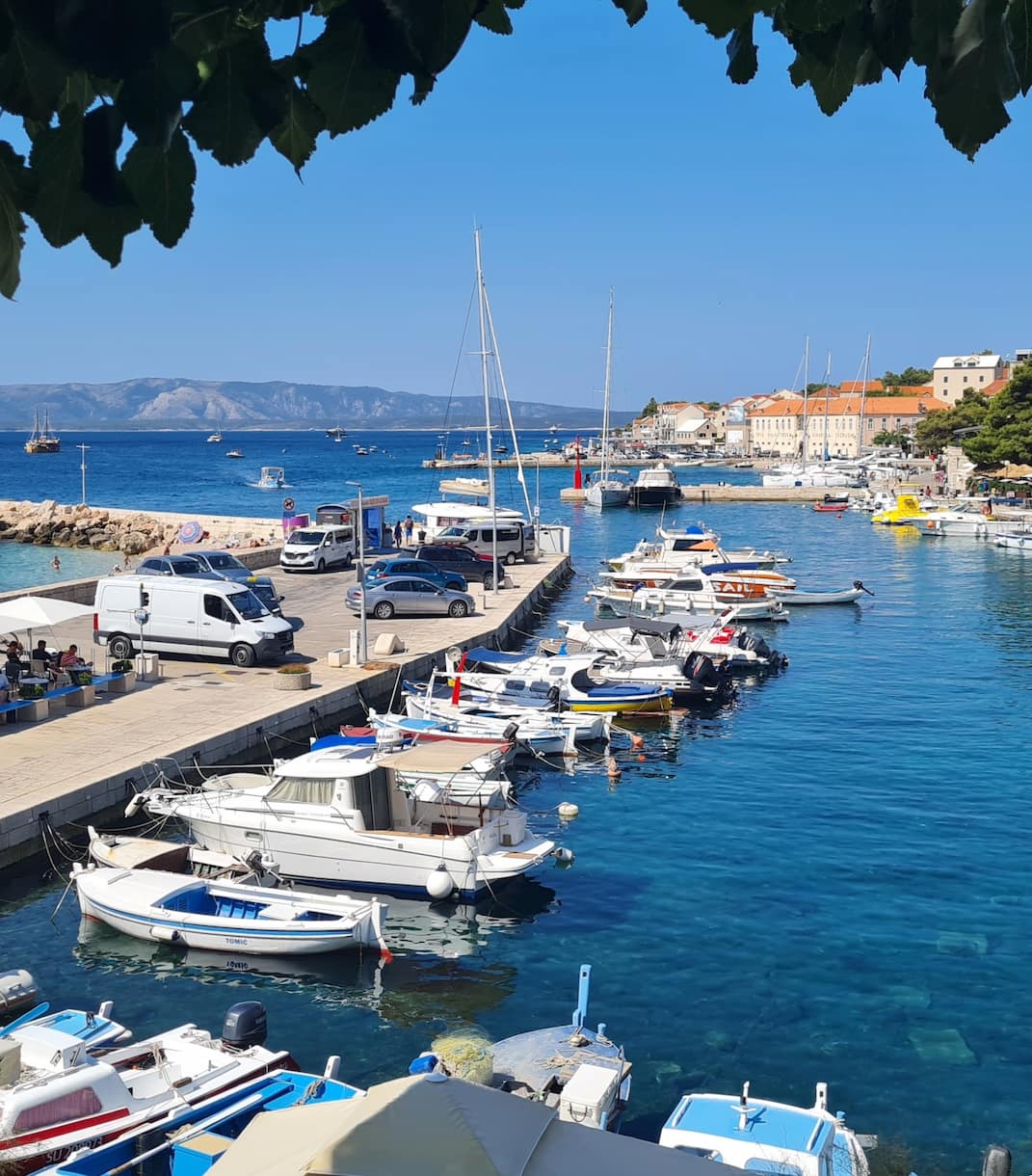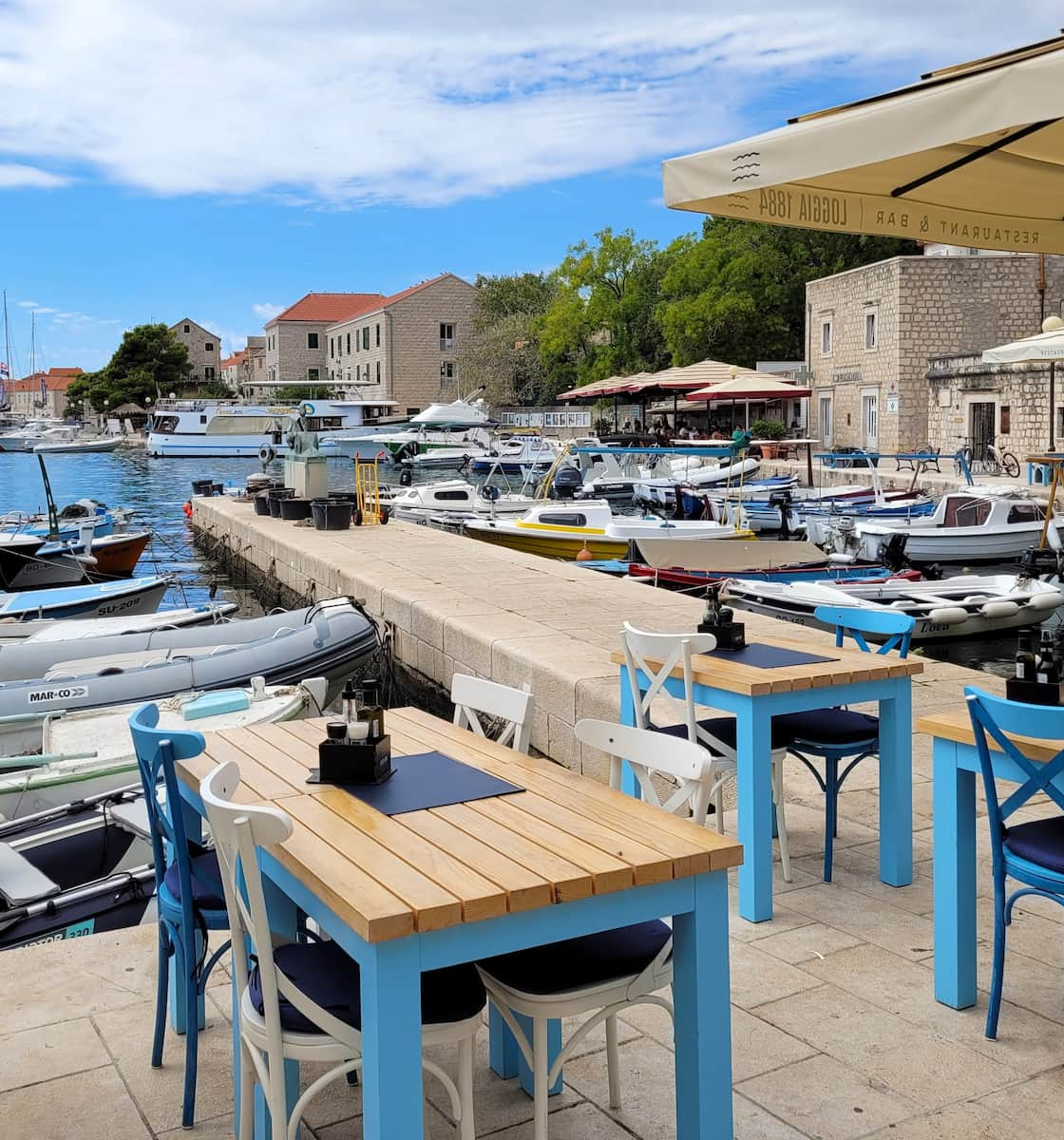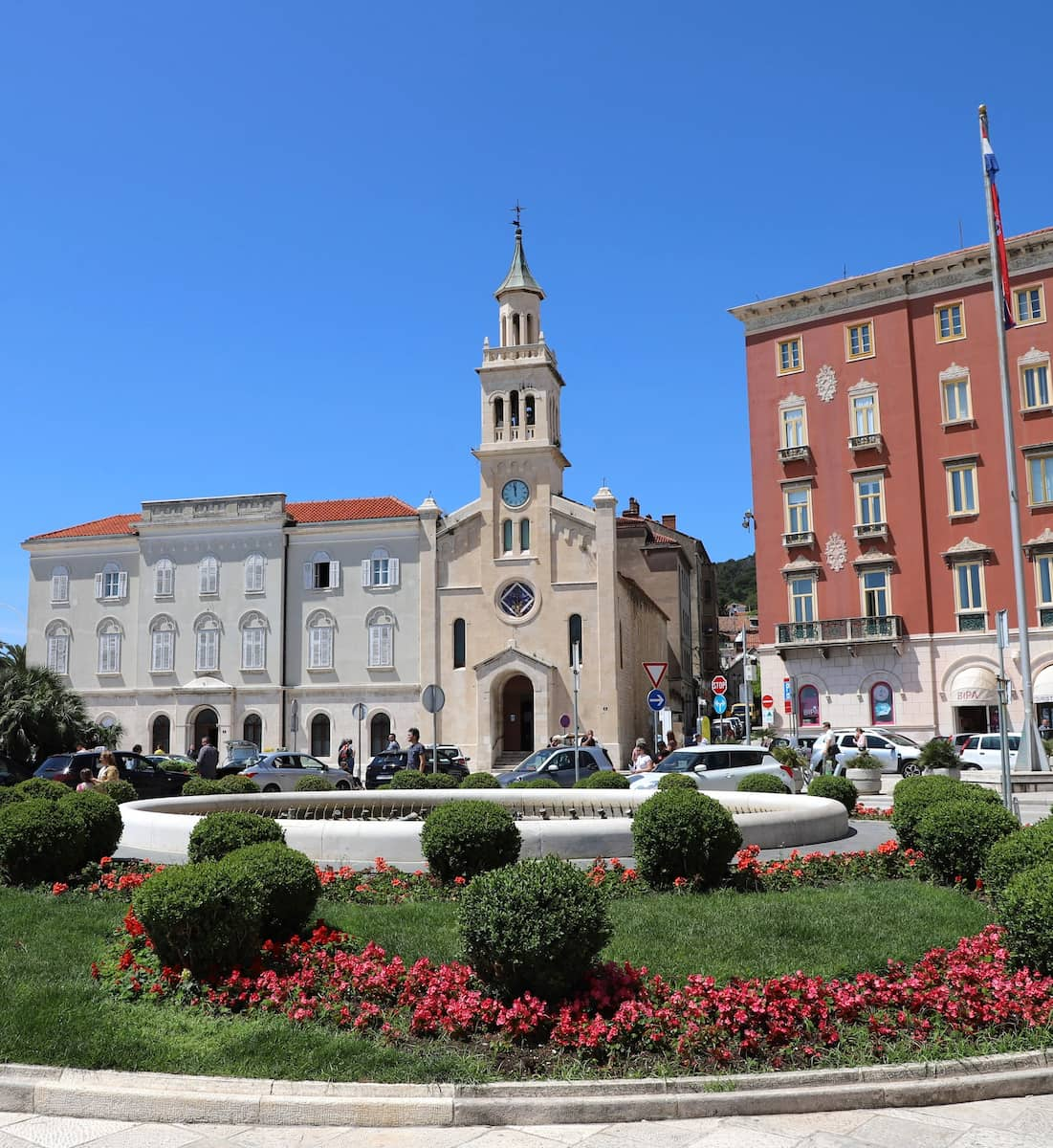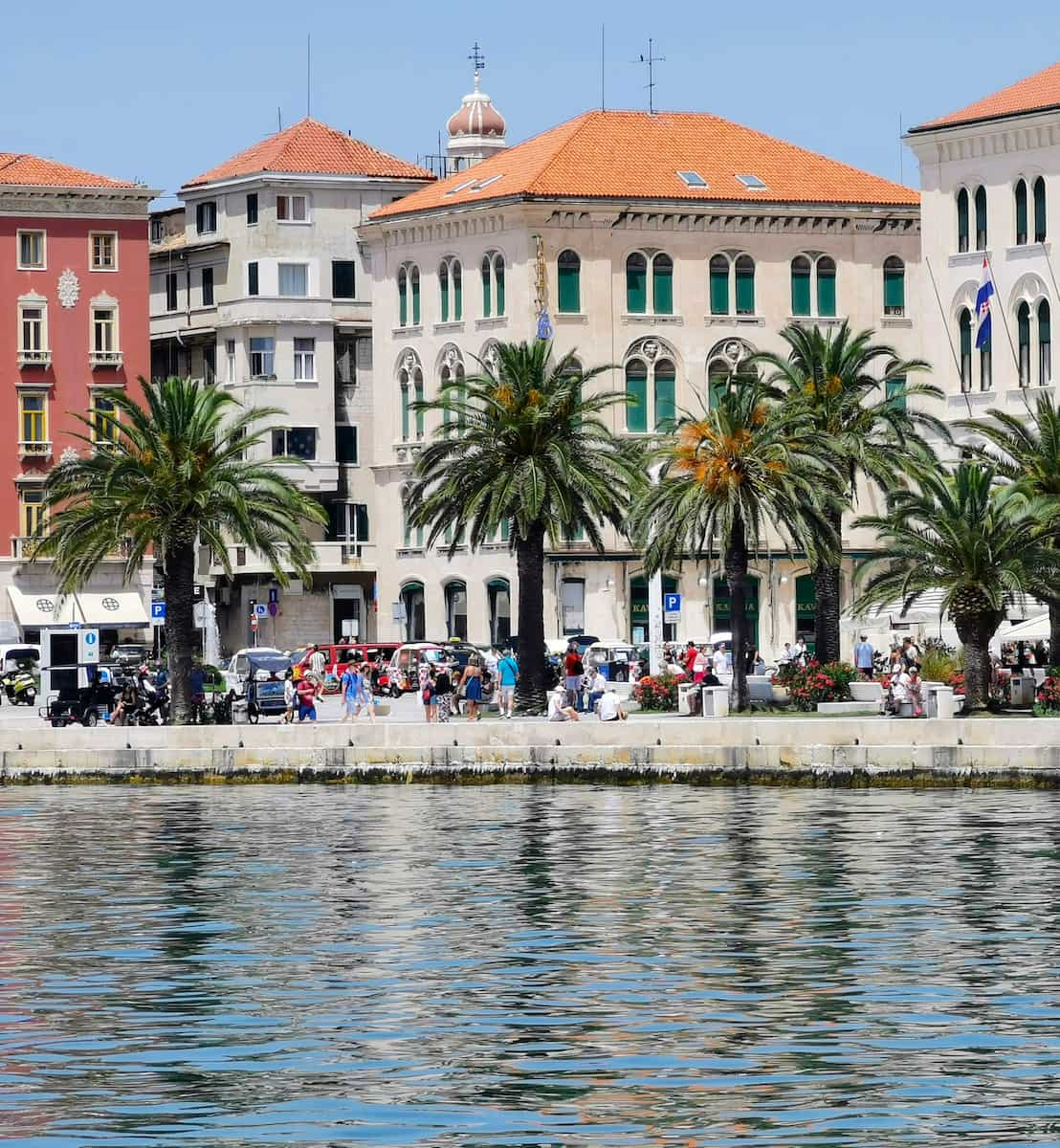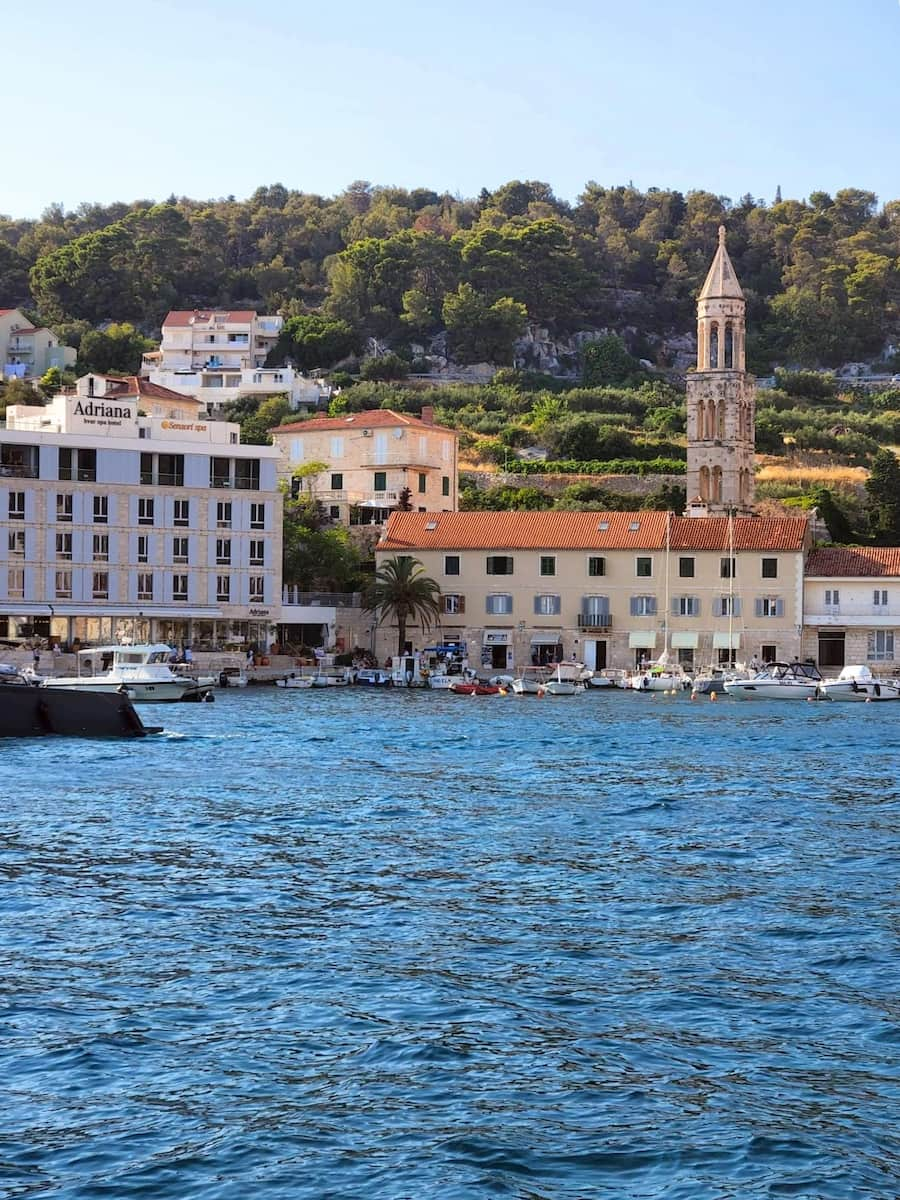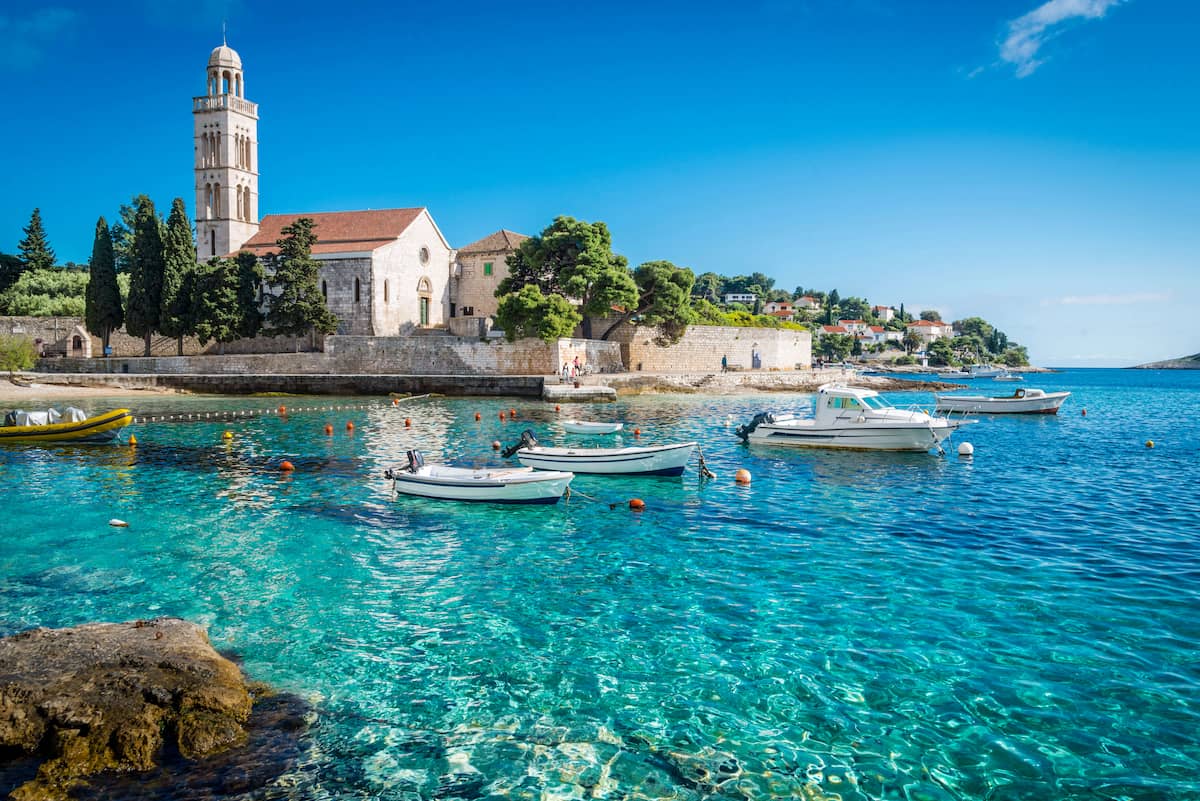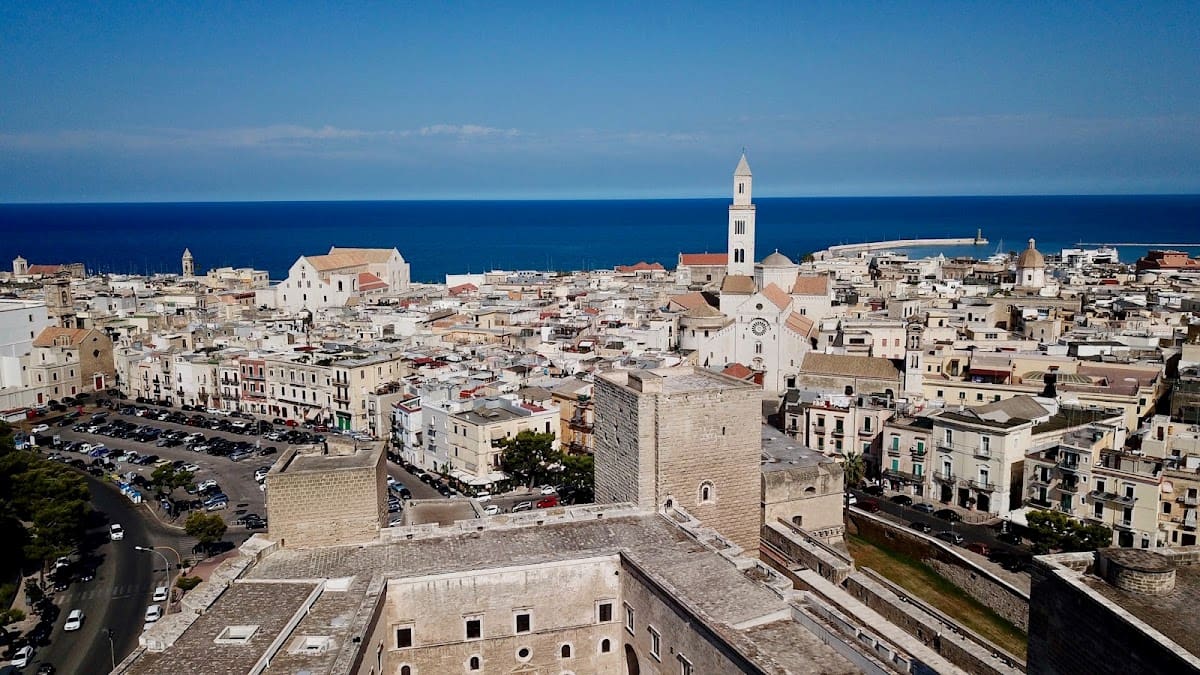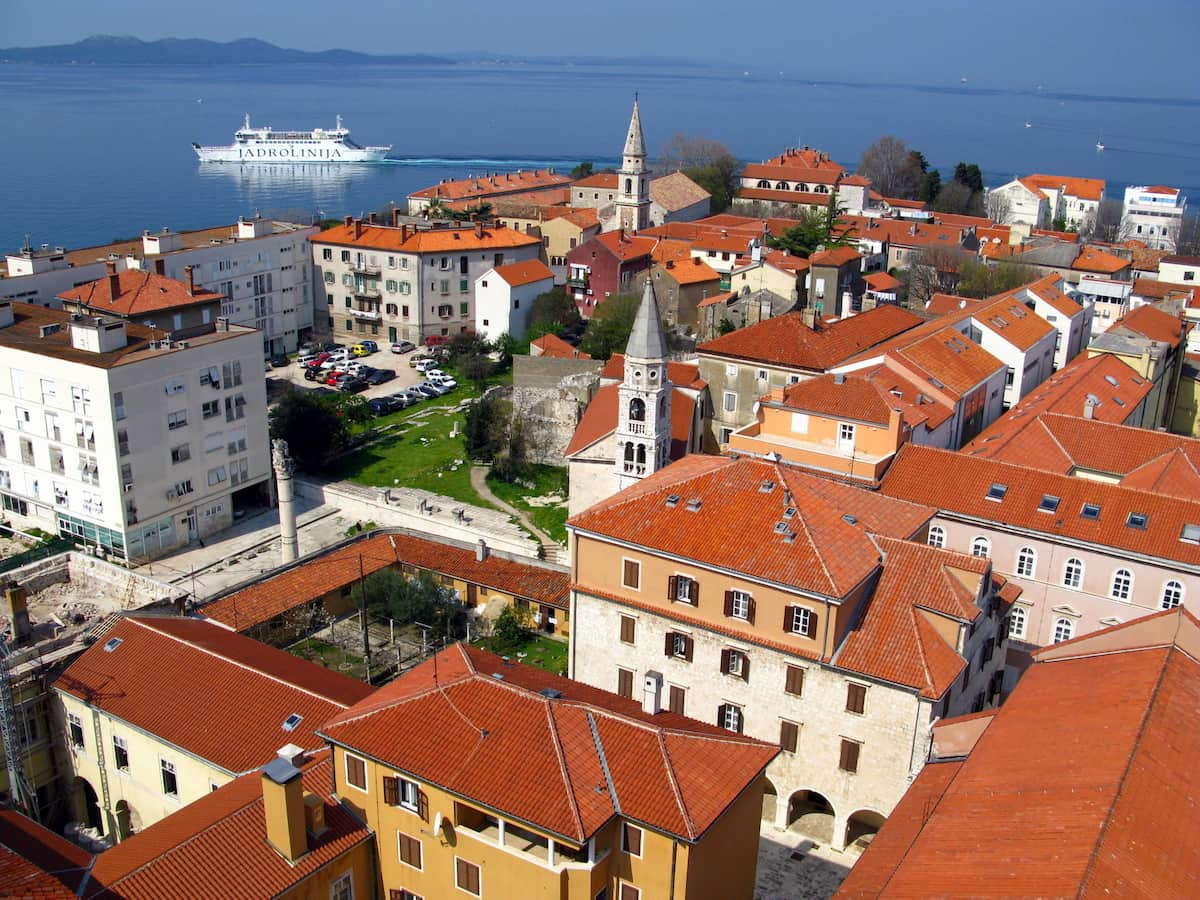If you’re planning to visit Brač, you’re in for an unforgettable journey to one of Croatia’s most stunning islands. Brač Island is famous for its breathtaking beaches, like the iconic Zlatni Rat in the town of Bol, and the panoramic views from the top of Vidova Gora, the highest peak in the Adriatic. But that’s not all – the island’s rich history, including its renowned Brač stone used in Diocletian’s Palace in Split, makes it a destination full of surprises.
🏡 Where to stay in Brac Island:
- 💎 Luxury Hotel: Aminess Velaris Resort
- 🏨 4-Star: Hotel SOL
- 🛏️ 3-Star: Villa Daniela
- 💸 Cheap: Palute
- 🏢 Apartment: Apartments Villa Azzurra Bol
- 👨👩👧👦 For Families: Belado Residence Bol
- 🏩 For Couples: Villa Mira
👩🏻 Best guided tours:
- Feel and Taste island Brac with local experts from € 65 (⭐️ 4.8/5)
- Biking Vidova Gora from € 85 (⭐️ 4.7/5)
- Split: Old Town and Diocletian Palace Walking Tour from € 22 (⭐️ 4.9/5)
- Split Food Tour: Discover Split One Bite At A Time from € 55 (⭐️ 4.8/5)
- Tuk Tuk Sightseeing Tour of Hvar from € 70 (⭐️ 4.6/5)
Best Things to Do in Brac, Croatia
1. Zlatni Rat Beach
Golden wonder. The moment I first laid eyes on Zlatni Rat Beach, I knew I’d found something special. This iconic triangular strip of pebbles stretches like a golden horn into the crystal-clear Adriatic Sea. What many visitors don’t realize is that the tip of this beach actually changes shape with the currents and winds – I’ve visited three times and seen a slightly different silhouette each time! The contrast between the golden pebbles and the intense turquoise water creates a visual feast that’s impossible to forget.
Water activities. I spent an entire afternoon testing the waters at Zlatni Rat, which has become a paradise for windsurfers thanks to the reliable afternoon winds. The western side of the beach typically has stronger winds and waves, while the eastern side remains calmer – perfect if you’re traveling with kids. I rented a paddleboard for 150 kuna (about €20) per hour and glided across the transparent water, spotting fish darting beneath me. The sensation of floating above such clarity while gazing at the pine forest backdrop was truly magical.
Practical comforts. Despite being Brac’s most famous beach, Zlatni Rat isn’t as crowded as you might expect, especially if you arrive before 10 AM. I found plenty of space to spread out my towel under the natural shade of the century-old pine trees. The beach is lined with cafés and snack stands on its western edge where I enjoyed a refreshing local beer while watching the sunset paint the white pebbles gold.
| Zlatni Rat Beach Details | |
|---|---|
| Location | 2 km west of Bol town (25-minute walk along a shaded promenade) |
| Facilities | Showers, changing rooms, toilets, cafés, water sports rentals |
| Sunbed & Umbrella | 80-100 kuna (€10-13) per day |
| Water Sports | Windsurfing: 300 kuna (€40) per hourPaddleboarding: 150 kuna (€20) per hourKayak: 200 kuna (€27) per hour |
2. Blaca Hermitage
Hidden wonder. Tucked away in a remote limestone canyon on Brac’s southern coast, Blaca Hermitage (Pustinja Blaca) was the most unexpected discovery of my trip. This remarkable monastery, built into the side of a cliff, began as a simple cave dwelling in the 16th century when Glagolitic priests fled from Ottoman invaders. I chose to access it via boat tour from Bol (450 kuna/€60), which took me along the stunning coastline to a beautiful bay. From there, a moderate one-hour hike led me through rugged terrain to this architectural marvel that seems to grow organically from the rock face.
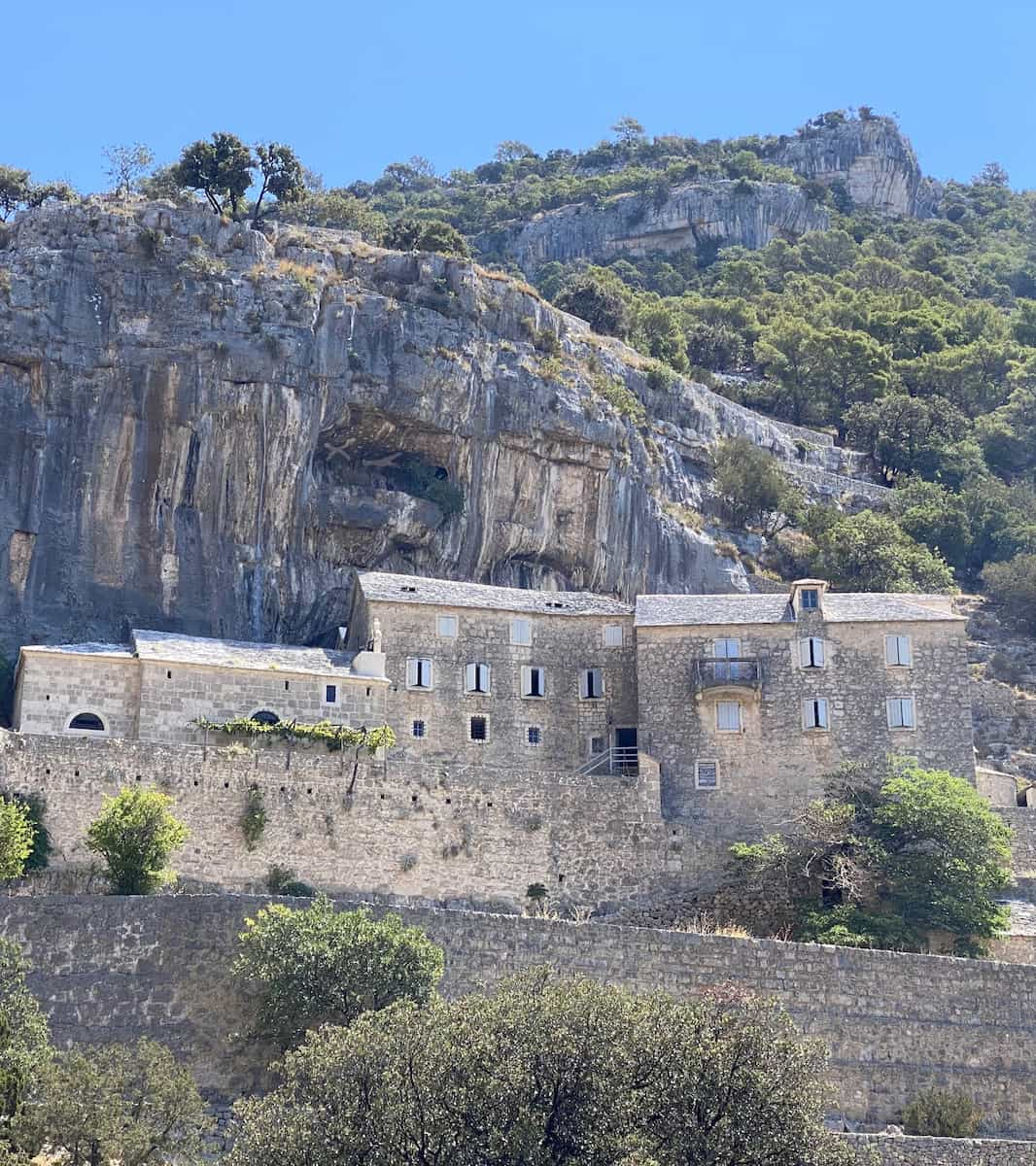

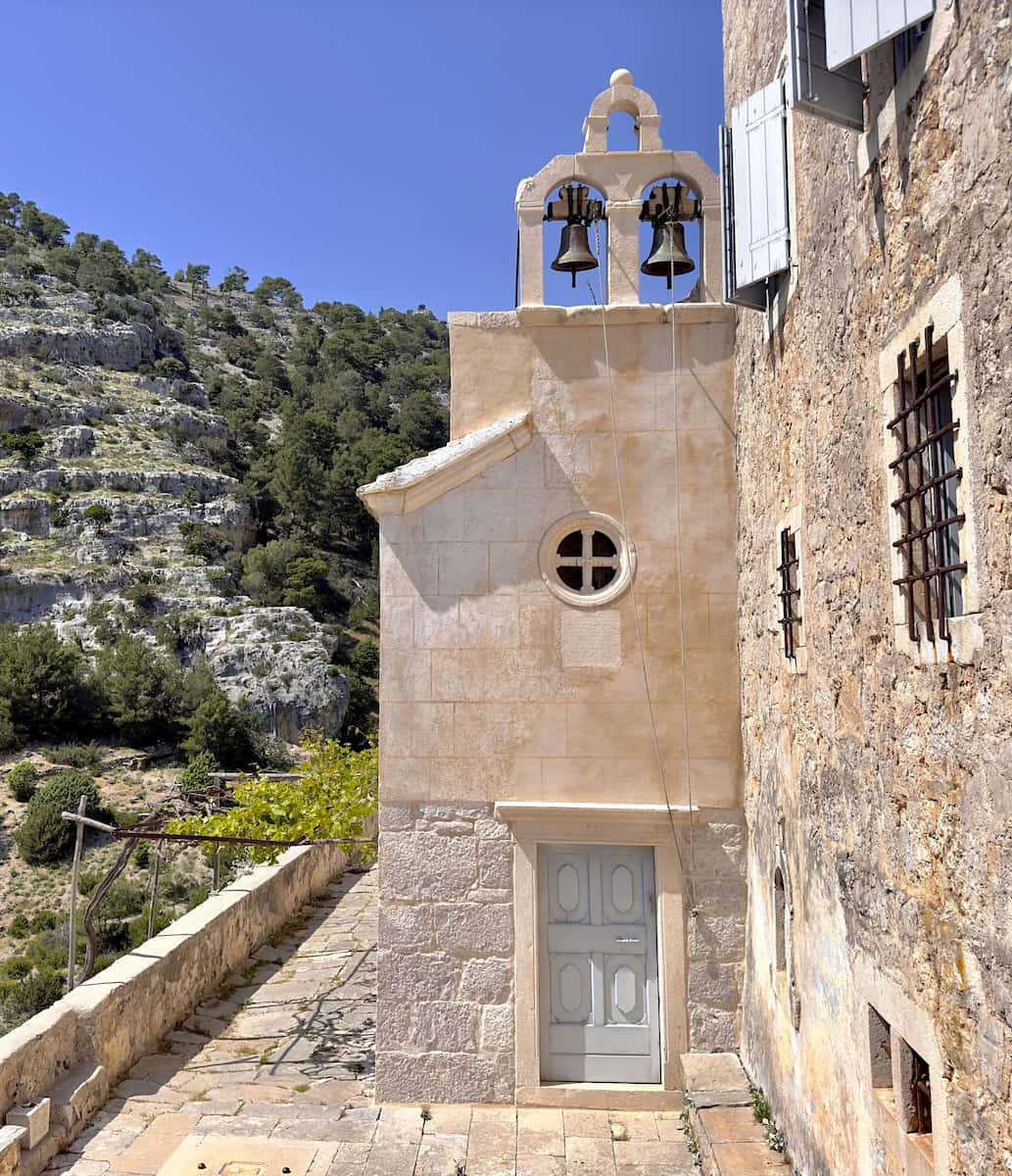
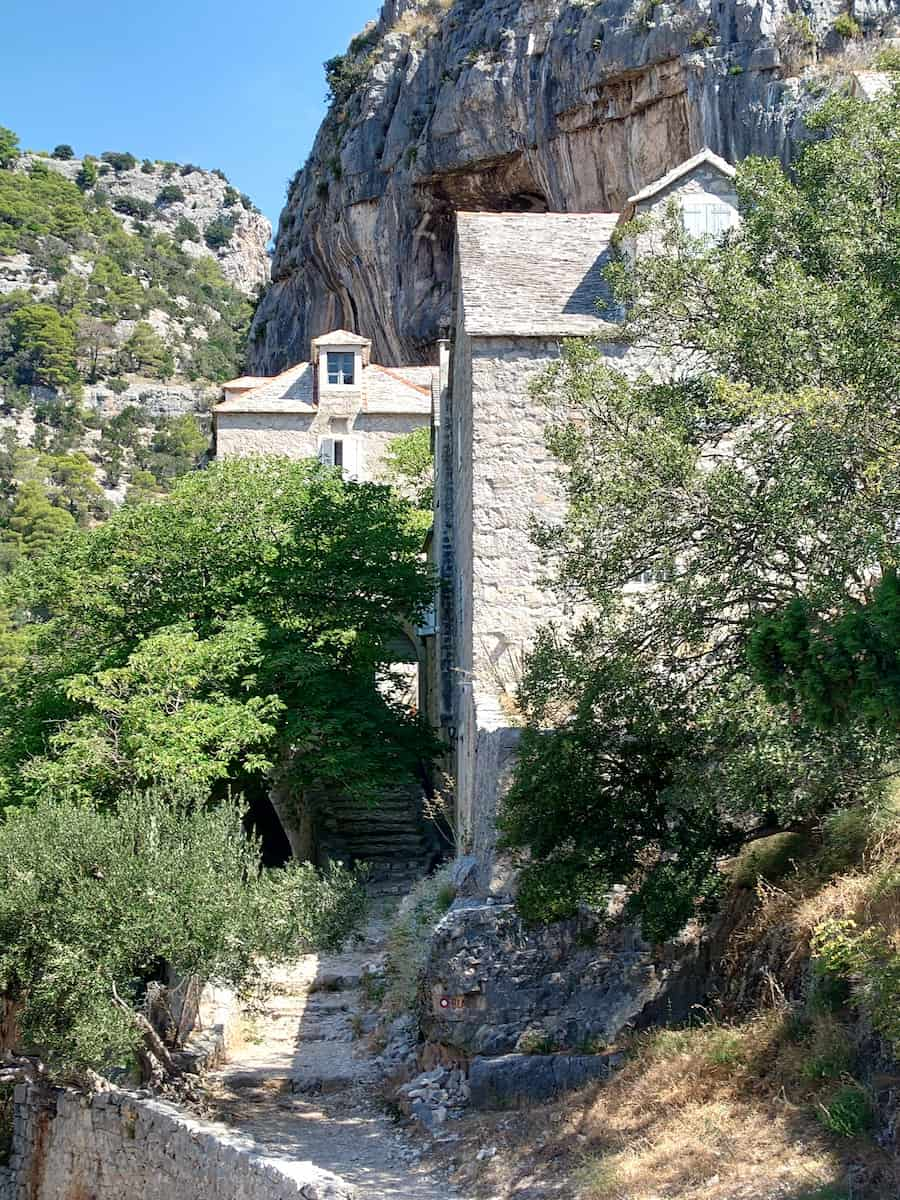
Historical marvel. Walking through Blaca’s stone doorway felt like stepping back in time. My guide explained how generations of monks transformed this isolated spot into a self-sufficient community with a church, living quarters, kitchen, and agricultural facilities. I was astonished by the monastery’s 8,000-volume library and the astronomical observatory equipped with a powerful telescope – evidence of the monks’ intellectual pursuits despite their remote location. The most surprising artifact was a 400-kilogram piano that was carried up the steep path by hand!
Natural immersion. After touring the monastery’s interior (no photos allowed inside), I spent time exploring the surrounding landscape. The silence here is profound, broken only by birdsong and the rustling of leaves. Standing on the stone terrace, I gazed across the valley to the abandoned village of Dragovode, where children once walked daily to attend school at Blaca. The hermitage’s isolated setting, with no modern infrastructure in sight, creates a powerful connection to the past.
| Blaca Hermitage Details | |
|---|---|
| Location | Southern coast of Brac, between Bol and Milna |
| Access Options | 1. Boat tour from Bol + hiking (45 min boat, 1 hour hike)2. Drive to northern parking lot + hike down (40 min)3. Organized tour with transfer from major towns |
| Entrance Fee | Adult: 40 kuna (€5.30)Students: 20 kuna (€2.70)Guided tour: Additional 40 kuna (€5.30) |
| Boat Tour from Bol | 450 kuna (€60) including transport and guide |
3. Olive Oil Museum
Liquid gold heritage. Tucked away in the ancient village of Škrip, the Olive Oil Museum offered me a fascinating glimpse into Brac’s olive oil tradition. Housed in a beautifully restored stone building that once functioned as a working oil mill, this museum tells the story of the island’s relationship with olive cultivation dating back centuries. The moment I stepped inside, the distinctive aroma of olive oil filled my nostrils, immediately connecting me to this cornerstone of Mediterranean culture.
Authentic experience. My guide walked me through each step of the traditional oil-making process, demonstrating how olives were once crushed using the massive stone mill powered by donkeys. I was particularly impressed by the original “Thomas Holt” olive press from Trieste, which the family purchased in the early 20th century. The museum displays all the traditional tools used for harvesting, pressing, and storing olive oil – from handwoven bags used to hold the olive paste to the earthenware containers for storing the precious oil. The attention to detail in the exhibits made the historical process come alive.
Tasting delights. The highlight of my visit was undoubtedly the tasting session. I sampled several varieties of extra virgin olive oil produced by the family, learning to detect the subtle peppery finish that indicates high-quality oil. The museum also offers delicious olive-based products like black and green olive spreads, which I enjoyed with fresh bread. I couldn’t resist purchasing a bottle of their award-winning oil to take home – a perfect souvenir that captures the essence of Brac island.
| Olive Oil Museum Details | |
|---|---|
| Location | Village of Škrip (15 km from Bol, 8 km from Supetar) |
| Entrance Fee | Adult: 40 kuna (€5.30)Children (7-18): 20 kuna (€2.70)Under 7: Free |
| Tasting Menu Options | Menu 1 (olive spreads, olives, oil, wine): 105 kuna (€14)Menu 2 (adds cheese and prosciutto): 150 kuna (€20) |
⭐ Best activities
- Feel and Taste island Brac with local experts – Spend a day on the island of Brac with this guided tour. You’ll learn about–and taste–local products, take in views of the island from the Vidova Gora viewpoint, dine on an included lunch of local fare, and visit a stone quarry, with plenty of time left over to swim in the sea.
4. Dominican Monastery
Coastal sanctuary. Perched on a picturesque peninsula called Glavica just east of Bol town, the Dominican Monastery creates an unforgettable silhouette against the azure Adriatic. I approached via a pleasant 10-minute walk from Bol’s center, following a coastal path that offered stunning sea views. The 15th-century complex rises from the rocks like a natural extension of the coastline, its stone walls glowing golden in the afternoon sun. I felt a sense of peaceful isolation as I entered the monastery grounds, despite being so close to the bustling town center.
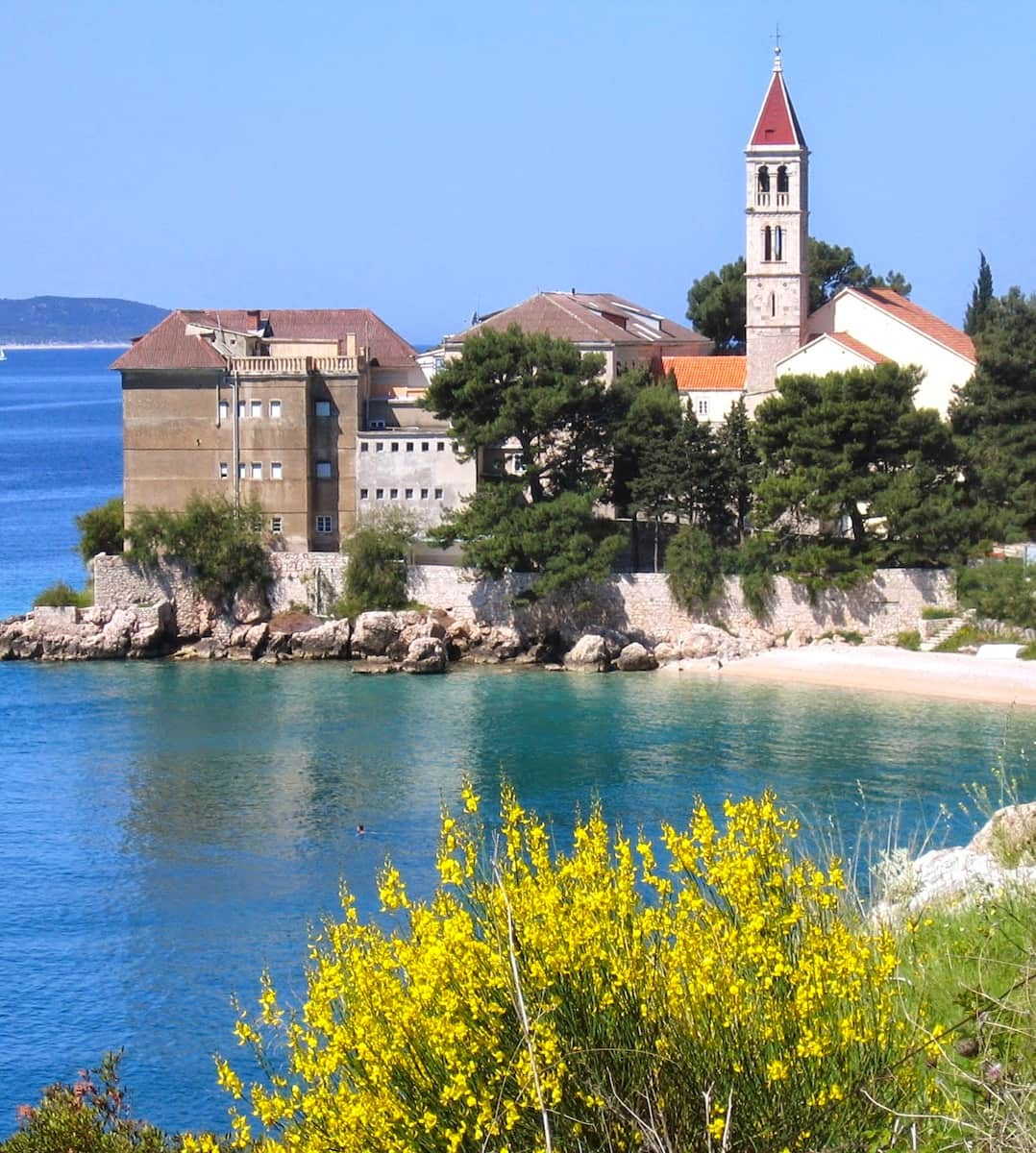
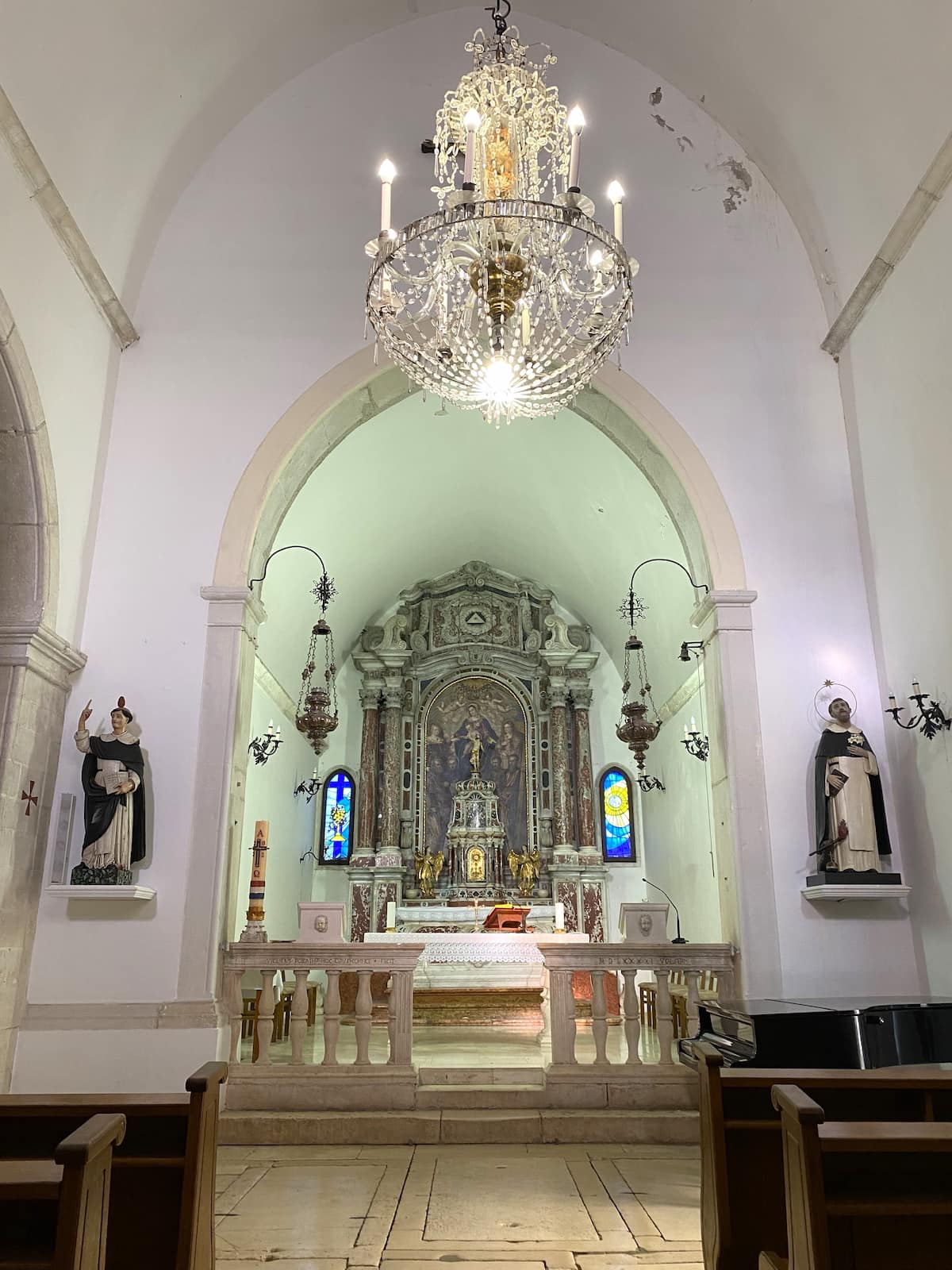
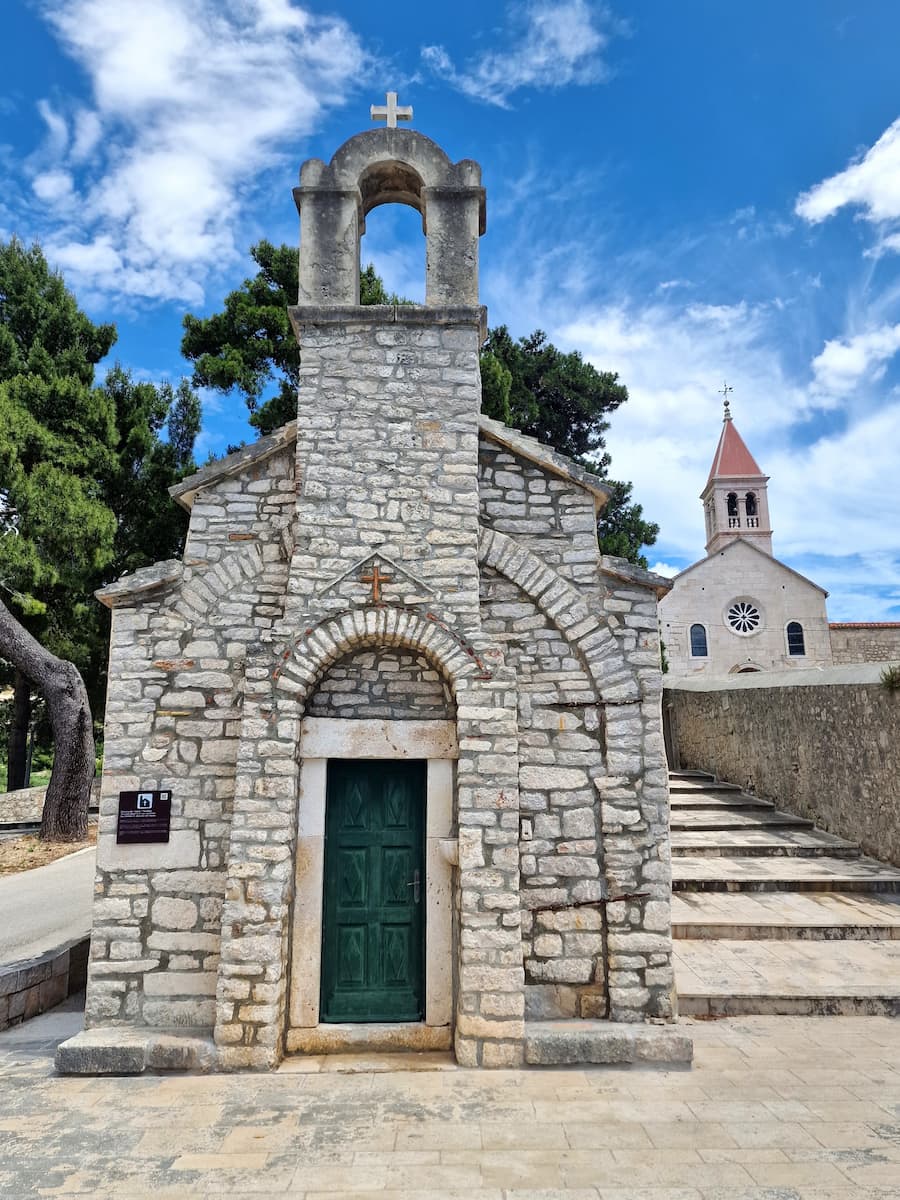

Cultural treasure trove. Inside the monastery museum, I discovered an impressive collection that spans centuries of history. The highlight for me was seeing Croatia’s first printed book – a remarkable piece of cultural heritage. The museum houses valuable collections of prehistoric artifacts, ancient coins, underwater archaeological finds, and religious vestments. I was particularly moved by the main altar in the Church of St. Mary of Mercy, crafted by the renowned Venetian painter Jacopo Tintoretto. The baroque paintings by Bartolomeo Litterini throughout the monastery showcase the artistic connections between this small island and the wider European cultural scene.
Tranquil retreat. After exploring the museum, I spent time in the monastery’s peaceful courtyard, where the sound of gentle waves provided a meditative soundtrack. The monastery’s strategic position offers spectacular views across the channel to Hvar Island. Just steps away, I discovered Martinica Beach – a serene pebble cove that feels worlds away from the more popular Zlatni Rat. I ended my visit with a refreshing swim in the crystal-clear waters before enjoying a drink at the casual beach bar while watching the sun set behind the monastery walls.
| Dominican Monastery Details | |
|---|---|
| Location | Glavica peninsula, 800m east of Bol harbor |
| Entrance Fee | Adult: 40 kuna (€5.30)Students/Seniors: 20 kuna (€2.70)Children under 12: Free |
| Nearby | Martinica Beach, Ribarska Kućica restaurant |
5. Vidova Gora
Breathtaking summit. Standing at 778 meters above sea level, Vidova Gora is the highest peak of all Adriatic islands, and the hike up was one of my most rewarding experiences on Brac. I set out early one morning from Bol, following the red and white trail markers that guide hikers up the mountain. The path winds through fragrant pine forests before opening up to reveal increasingly spectacular views. When I finally reached the summit, I was rewarded with a panorama that literally took my breath away – Zlatni Rat Beach below looked like a tiny white arrow pointing into the sapphire sea.
Hiking adventure. The trail is moderately challenging but absolutely worth the effort. It took me about 3 hours to reach the top, climbing steadily through changing landscapes. I passed through aromatic Mediterranean scrubland filled with wild herbs that released their scent with each step. The higher sections have some loose rocks, so I was glad I wore proper hiking shoes. I encountered several fellow hikers along the way, including locals who shared stories about the mountain’s history and pointed out distant islands visible from various viewpoints.
Summit rewards. After catching my breath at the summit, I discovered a small café where I treated myself to a well-deserved cold drink. The wooden cross marking the highest point makes for a perfect photo opportunity with islands Hvar and Vis visible in the distance. On exceptionally clear days, you can even spot the Italian coast! I spent nearly an hour at the top, soaking in the 360-degree views and enjoying the cool mountain breeze before beginning my descent.
| Vidova Gora Details | |
|---|---|
| Distance & Elevation | 10.6 km round trip, 715 meters elevation gain |
| Hiking Time | 3-5 hours total (depending on fitness level) |
| Best Time | April-June or September-October, start before 8 AM in summer |
⭐ Best activities
- Biking Vidova Gora – See Brac by bicycle on this group tour. Travel in an air-conditioned vehicle to the top of Vidova Gora, Brac’s highest peak, and ride your provided bicycle along a set path. Admire the variety of nature as you cycle past. Cycle through the village of Nerezisca and visit the Museum of Oil in Skrip. Take a break for a lunch of local products.
Things to Do in Brac with Kids
1. Beaches on Brac Island
Family-friendly shores. Traveling with my sister’s kids last summer, I quickly discovered that not all Brac beaches are created equal when it comes to family enjoyment. Lovrecina Bay near Postira became our go-to spot thanks to its rare sandy shoreline – a welcome change from the typical pebbles that dominate Croatian beaches. The shallow, crystal-clear water extends for nearly 30 meters before deepening, creating a natural kiddie pool where my niece and nephew splashed for hours without me constantly hovering. The gentle slope into the sea meant even my water-shy 4-year-old niece gradually built up confidence to venture further each day.
Beach amenities. What really made Lovrecina stand out was the thoughtful setup for families. Unlike some of Brac’s more rugged beaches, here I found clean changing facilities, freshwater showers, and even a small playground set back from the shore. The beach bar serves reasonably priced ice cream (15 kuna/€2 for a scoop) that became our daily ritual. I appreciated that the sunbeds weren’t packed like sardines – we paid 80 kuna (about €10.50) for two loungers and an umbrella, but there was also plenty of free space to set up your own gear. The ancient Roman villa ruins just behind the beach provided an impromptu history lesson and much-needed shade during the midday heat.
Water adventures. The highlight for my 8-year-old nephew was renting a pedal boat with a slide attached to the back. For 150 kuna (€20) per hour, this simple pleasure provided endless entertainment as he slid into the sea again and again while I pedaled around the bay. For older kids, I spotted kayak rentals (100 kuna/€13 per hour) and stand-up paddleboards (120 kuna/€16 per hour).
2. Sutivan Nature Park
Animal encounters. Just 2 kilometers from Sutivan toward Milna, I discovered a hidden gem that became the highlight of our family trip to Brac. Sutivan Nature Park combines a mini-zoo with a botanical garden, creating a perfect day out for families. My niece and nephew were thrilled to get up close with goats, sheep, and donkeys – a welcome change from the beach routine. What made this experience special was how interactive it was; the friendly staff encouraged the kids to help feed some of the animals and even arranged a short donkey ride around the park grounds. The look of pure joy on my nephew’s face as he gently stroked a baby goat is something I’ll never forget.
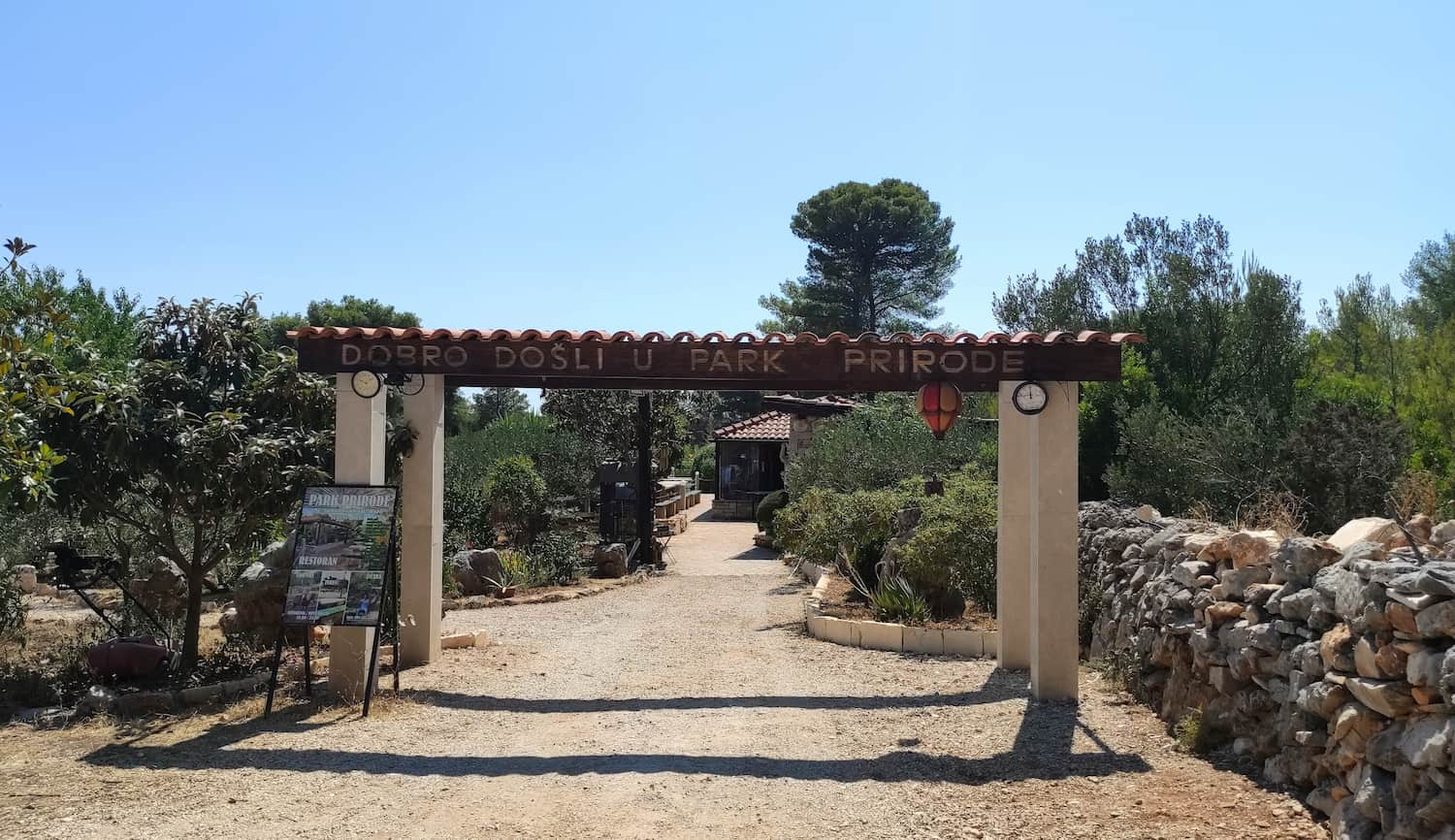
Adventure playground. Beyond the animal encounters, what kept us at the park for nearly the entire day was the variety of activities available. The zipline was an instant hit with my 8-year-old nephew, who must have gone down it twenty times in a row. Meanwhile, my 5-year-old niece bounced endlessly on the trampoline and built elaborate castles in the sand playground. I appreciated how the activities catered to different ages and energy levels, allowing each child to find something they enjoyed. The natural shade from pine trees throughout the park also provided welcome relief from the midday sun – a crucial consideration when traveling with kids in Croatia’s summer heat.
| Sutivan Nature Park Details | |
|---|---|
| Location | 2 km from Sutivan toward Milna (northwest Brac) |
| Opening Hours | April-October: 9 AM – 7 PM July-August: 9 AM – 9 PM Closed November-March |
| Entrance Fee | Adults: 60 kuna (€8) Children (3-12): 40 kuna (€5.30) Family ticket (2+2): 180 kuna (€24) |
| Activities | Zipline: 30 kuna (€4) per ride Donkey ride: 40 kuna (€5.30) for 10 minutes Trampoline & playground: Included in entrance fee |
Free Things to Do in Brac
1. Dragon’s Cave
Mysterious allure. My exploration of Dragon’s Cave near Murvica village turned out to be one of the most fascinating free experiences on Brac Island. The cave itself, known locally as Zmajeva Špilja, holds an air of mystery that captivated me from the moment I learned about it. While guided tours are available for a fee, I discovered that viewing the exterior and hiking the surrounding area costs nothing. The trail leading to the cave winds through olive groves and Mediterranean scrubland, with the scent of wild herbs rising from underfoot with each step. As I climbed higher, panoramic views of the Adriatic opened up before me, creating natural viewpoints that rivaled any paid attraction.
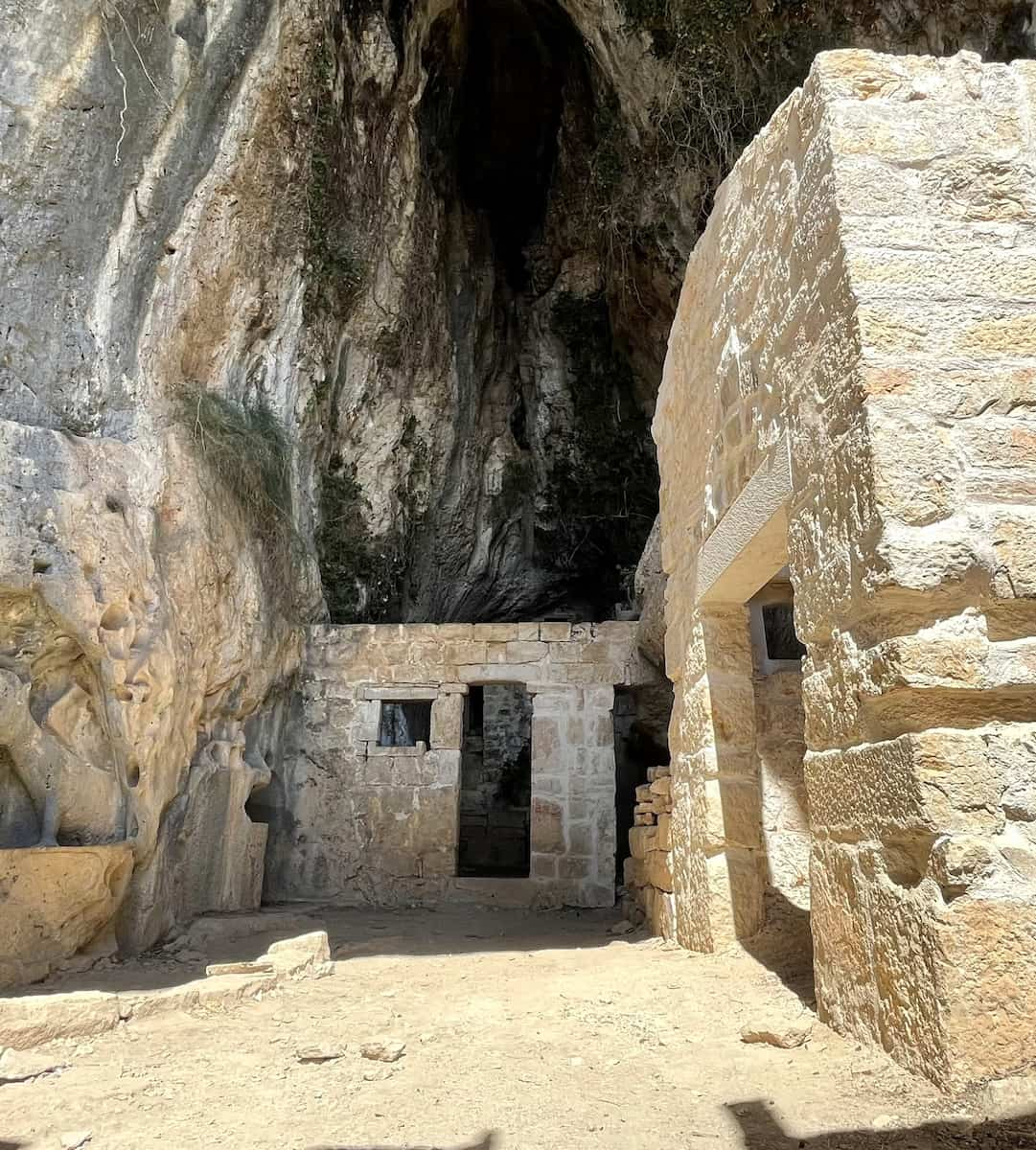
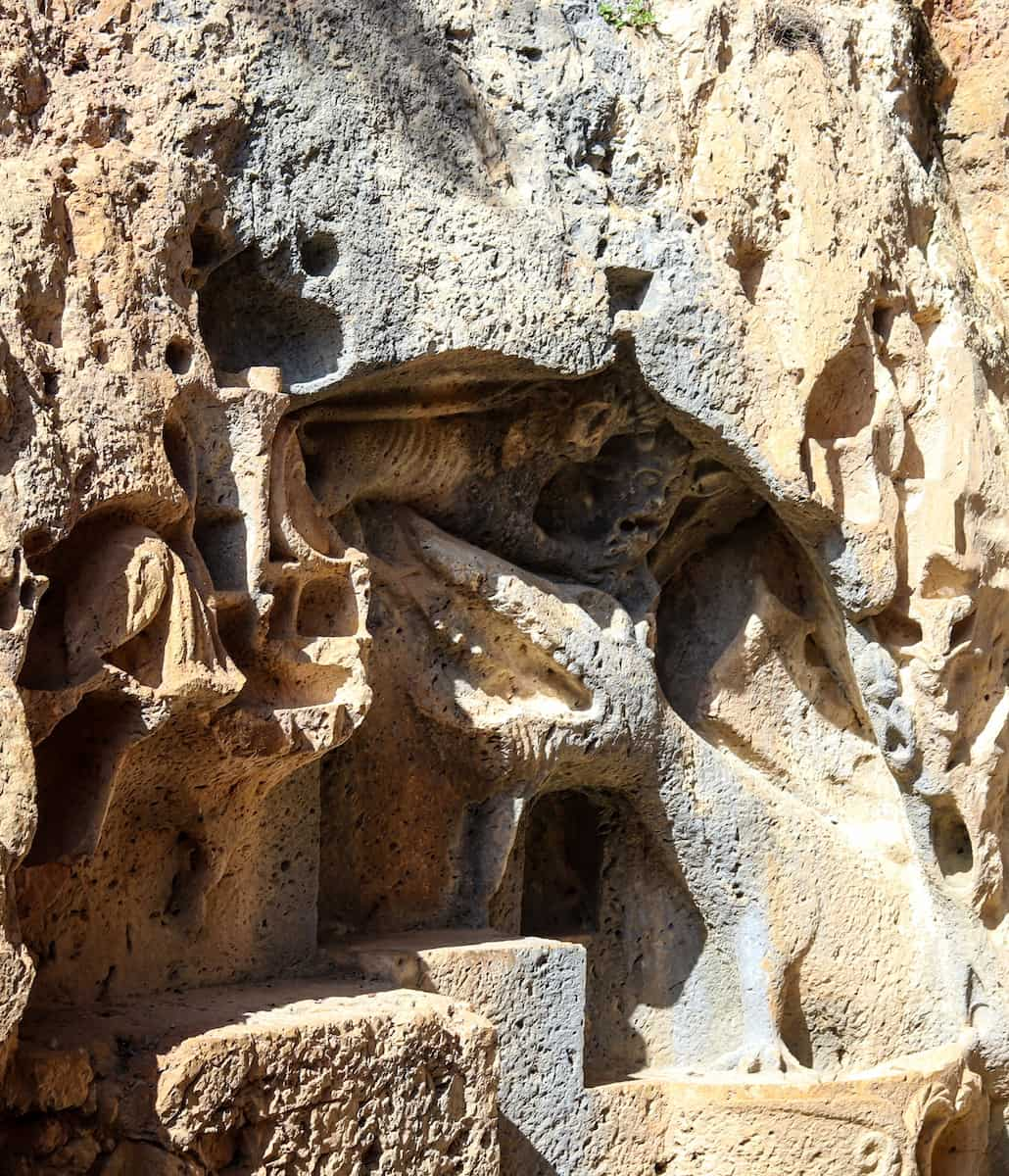

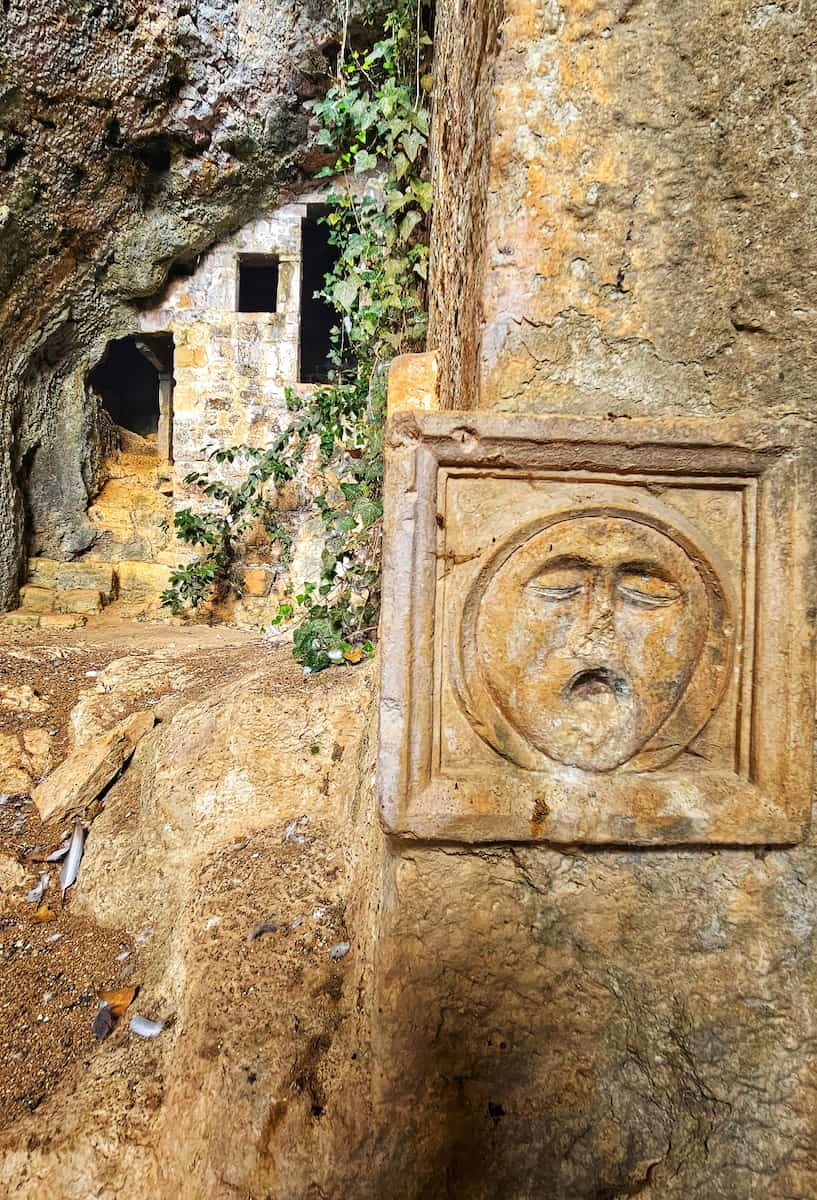
Scenic rewards. The journey to Dragon’s Cave is as rewarding as the destination itself. I took my time hiking the trail, stopping frequently to photograph wildflowers and unique rock formations along the way. The path offers several natural terraces where I paused to rest and absorb the spectacular coastal views. From these vantage points, I could see the famous Zlatni Rat Beach changing shape with the currents and tiny boats creating white wakes across the blue expanse. On my return journey, I took a different path down to Murvica village, where I discovered a small local konoba (tavern) with an elderly owner who shared stories of the cave’s legends over a refreshing glass of homemade lemonade.
| Dragon’s Cave Details | |
|---|---|
| Hiking Time | 30-40 minutes uphill from Murvica village |
| Trail Difficulty | Moderate – rocky terrain with some steep sections |
2. Murvica Beach
Hidden paradise. Just 4 kilometers west of bustling Bol, I discovered what quickly became my favorite free escape on Brac Island. Murvica Beach sits nestled beneath dramatic cliffs, accessible via a scenic coastal path that keeps away the crowds that flock to more famous shores. The moment I descended the final stretch of path and saw the pristine pebble beach with its impossibly blue water, I knew I’d found something special. Unlike Zlatni Rat with its organized rows of sunbeds, Murvica offers a wilder, more natural experience. The beach is framed by fragrant pine trees that provide natural shade, and the sound of cicadas creates a soothing soundtrack that perfectly complements the gentle lapping of waves.
Crystal waters. My first swim at Murvica Beach left me speechless. The water clarity here surpassed anything I’d seen elsewhere on the island, with visibility extending at least 15 meters below the surface. I spent hours snorkeling along the rocky edges of the cove, discovering an underwater world teeming with colorful fish, sea urchins, and even an octopus hiding among the rocks. What makes this experience even more special is that it’s completely free – unlike some beaches that charge for access or amenities, Murvica remains beautifully undeveloped. The gradual slope into deeper water makes it suitable for swimmers of all abilities, though the pebbles can be tough on tender feet.
3. Bol Port
Harbor rhythms. Wandering through Bol Port became my favorite evening ritual during my week on Brac Island. Unlike the busier beaches, the port area offers a free, authentic slice of Dalmatian coastal life that changes throughout the day. I loved watching the morning fishing boats return with their catch, followed by the mid-day ferry arrivals bringing new visitors, and finally the golden sunset casting long shadows across the stone promenade. The port’s natural horseshoe shape creates a perfect walking path with the sea on one side and charming stone buildings on the other. The scent of salt water mixed with fresh seafood from the waterfront restaurants created an atmosphere that felt quintessentially Mediterranean.
Sunset spectacle. The absolute highlight of Bol Port comes as the day ends. I discovered a perfect spot on the western side of the harbor where the setting sun transforms the water into a canvas of orange, pink, and purple hues. Local fishermen often gather here to repair their nets, creating silhouettes against the colorful sky that had me reaching for my camera every evening. One night, I was lucky enough to witness a traditional boat launching ceremony, complete with music and local rakija (fruit brandy) being shared among the crowd. These spontaneous moments of cultural connection cost nothing but created memories I couldn’t have purchased at any price.
| Bol Port Details | |
|---|---|
| Location | Central Bol, eastern coast of Brac Island |
| Walking Route | Western harbor → Central promenade → Dominican Monastery (45 minutes total) |
| Free Events | Summer concerts in the square (check bulletin board by tourist office) Fish market activity (mornings except Sunday) |
Seasonal Activities
Christmas
Festive traditions. Experiencing Christmas on Brac Island reveals a completely different side of this summer destination. During my December visit, I discovered that Croatian Christmas celebrations begin with St. Nicholas Day on December 6th. In Supetar, I watched children place shoes outside doors, hoping for small gifts overnight. The town square transformed with twinkling lights and a magnificent Christmas tree, creating a magical atmosphere far removed from summer beach crowds.

Local celebrations. The highlight was attending Midnight Mass at the Church of St. Peter in Supetar on December 24th. The service featured traditional Croatian Christmas carols echoing through ancient stone walls. Afterward, everyone gathered in the square to exchange greetings and share homemade rakija (fruit brandy). Several families invited me to join their celebrations, offering a genuine glimpse into island traditions that summer tourists never experience.
Seasonal flavors. Christmas on Brac centers around food. At Konoba Kopačina in Donji Humac, I sampled bakalar (salt cod) served on Christmas Eve with local olive oil and garlic. On Christmas Day, I joined a local family for lunch featuring pašticada – slow-cooked beef in a sweet-savory sauce with homemade gnocchi. The meal ended with fritule, small doughnut-like pastries flavored with rakija and citrus zest. These aromas still transport me back to that cozy stone dining room.
Summer
Festival fever. Summer on Brac explodes with cultural events showcasing the island’s traditions. Last July, I discovered the Fishermen’s Night festival in Postira (every Tuesday evening from mid-June through August). The harbor transformed into an open-air party where local fishermen grilled fresh sardines for just 30 kuna (€4). Live klapa music (traditional a cappella singing) filled the air as locals and tourists joined hands for circle dances. The joy of this celebration created one of my most treasured island memories.
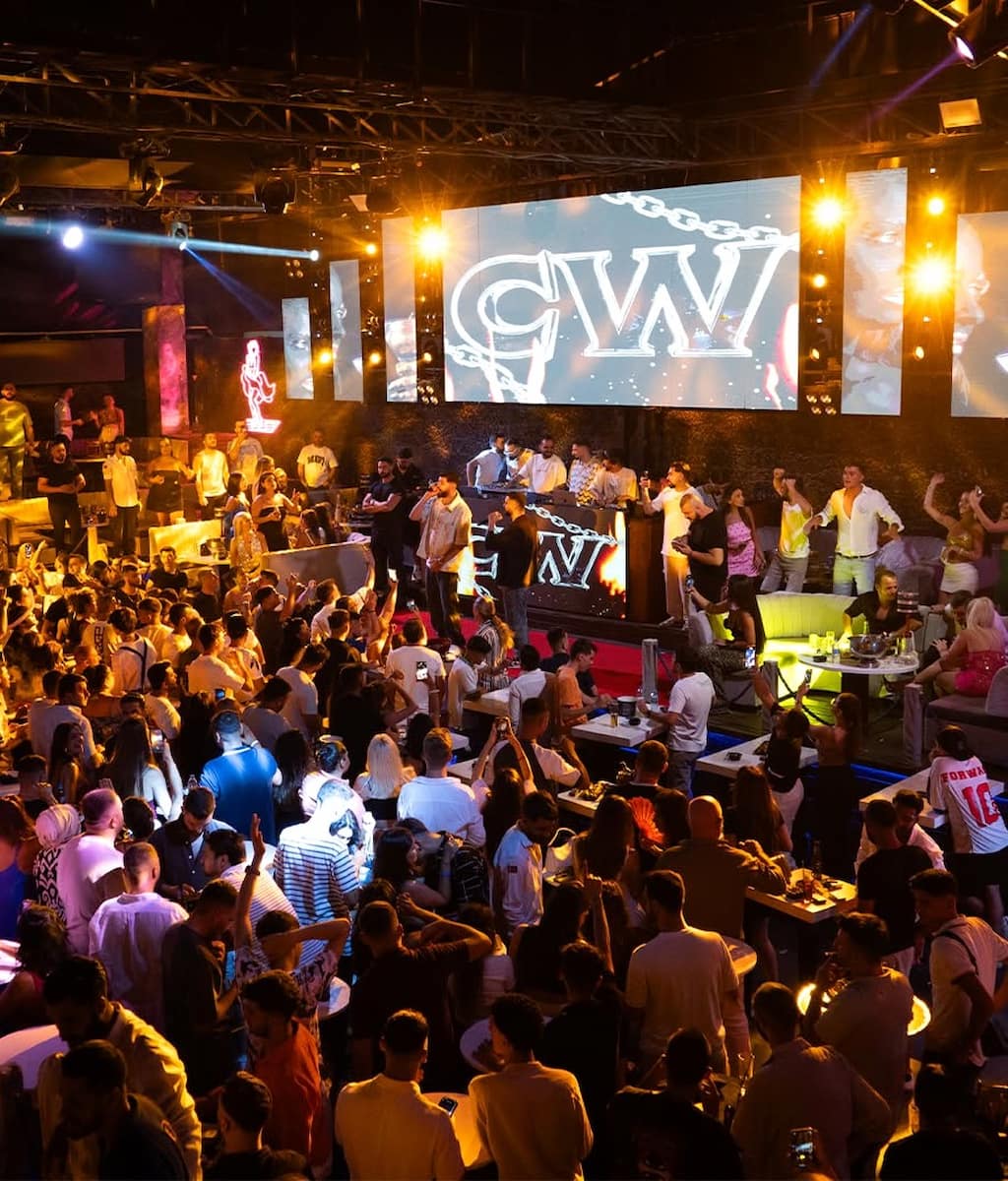
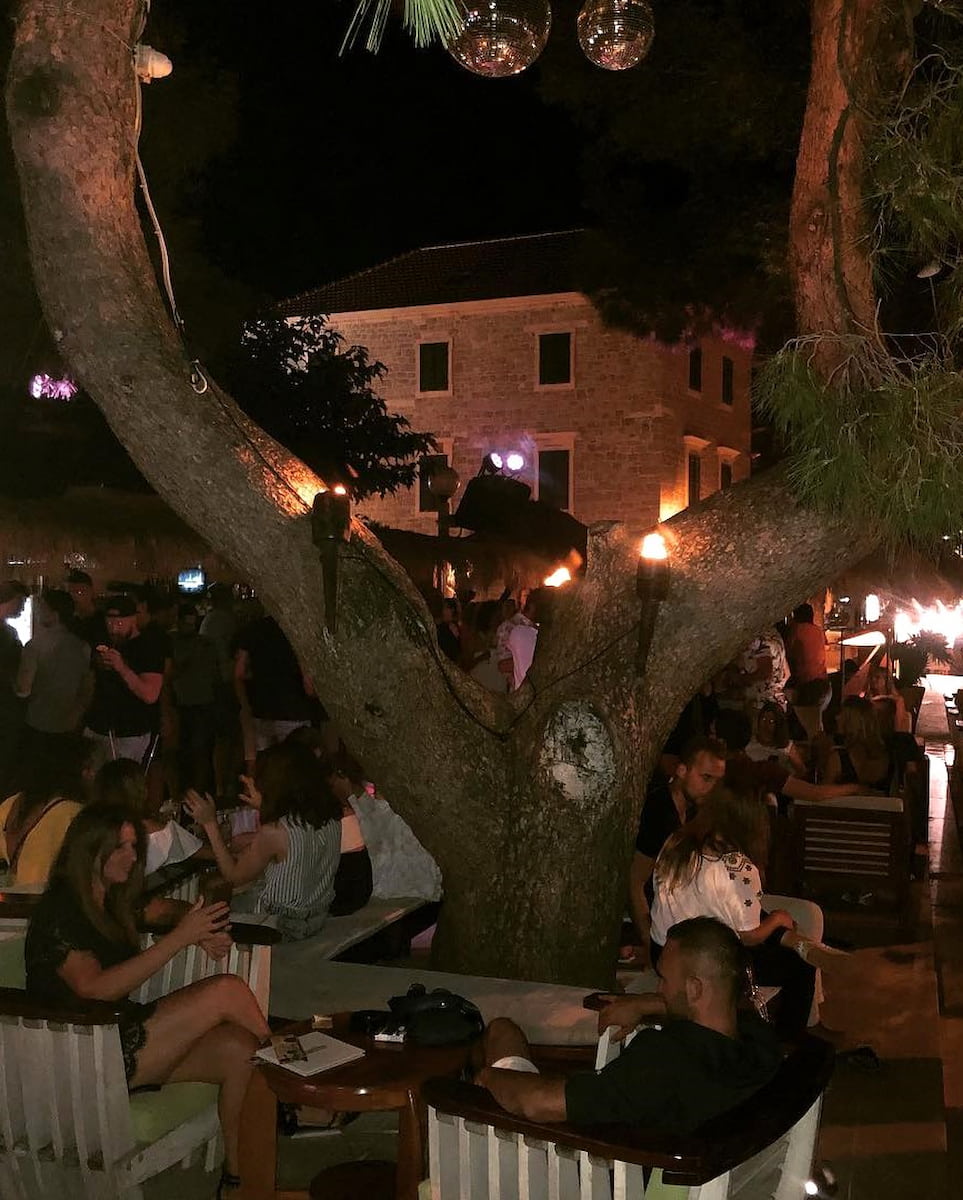
Water adventures. The highlight of my August visit was the annual Bol Summer Carnival (August 5th), when decorated boats parade along the coast from Bol Harbor to Zlatni Rat Beach. I rented a kayak for 100 kuna (€13) per hour to join the floating festivities. The sea was alive with colorful vessels, music, and laughter as locals in creative costumes sprayed water at each other. Later, the celebration continued with a beach party featuring local DJs and food stalls. This blend of ancient traditions with modern beach vibes perfectly captures Brac’s summer energy.
Cultural immersion. My most unexpected summer discovery was the Croatia Rediviva poetry evenings throughout July in Selca. In the town’s main square, beneath a starlit sky, poets from across Croatia recite works in Croatian. Even though I couldn’t understand every word, the emotional delivery created a powerful atmosphere. After the readings, I joined locals at Konoba Nono for grilled lamb and wine.
Spring
Olive celebrations. My spring visit coincided with the Olive Festival in Postira (April 22-24). This three-day celebration honors the island’s liquid gold with tastings, workshops, and competitions. I joined a guided tour of a local olive grove where a farmer demonstrated traditional harvesting techniques. The festival’s highlight was the olive oil competition, where I sampled dozens of varieties, learning to detect the peppery finish of high-quality oil. The entire village buzzed with activity as producers shared their family’s oil-making traditions.
Outdoor awakening. Spring transforms Brac with wildflowers and perfect hiking temperatures. During my April visit, I joined the annual Spring Hiking Weekend (April 15-17), organized by the Brac Outdoor Adventure Club. Guides led us along trails that aren’t on typical tourist maps, including a route from Škrip to Vidova Gora. As we hiked through meadows carpeted with purple sage and yellow broom, our guide pointed out endemic plant species. The 150 kuna (€20) fee included lunch at a shepherd’s hut – lamb slow-cooked under a metal bell (peka) that I still dream about.
Easter traditions. Easter on Brac provided insight into the island’s deep religious traditions. The Holy Week processions in Supetar (April 2-9) were unforgettable. On Good Friday, I joined hundreds of locals following a cross-bearer through candlelit streets while singing centuries-old hymns. The procession wound through town for over two hours. Easter Sunday brought a joyous atmosphere, with families sharing traditional foods. A local grandmother taught me to play the egg-tapping game (tucanje jaja), where participants compete to see whose decorated egg is strongest – a simple tradition that created instant connections.
Autumn
Grape harvest. My September visit to Brac coincided perfectly with the grape harvest season, allowing me to experience the island’s rich winemaking traditions firsthand. In Bol, I participated in the annual Grape Harvest Festival (September 25-27), where locals invited visitors to join the picking process in vineyards that cascade down the island’s southern slopes. For 200 kuna (€26), I spent a morning harvesting grapes alongside three generations of a family that has produced wine for over a century. The day culminated in a traditional feast where we stomped grapes barefoot in large wooden barrels – messy, joyful, and utterly authentic.
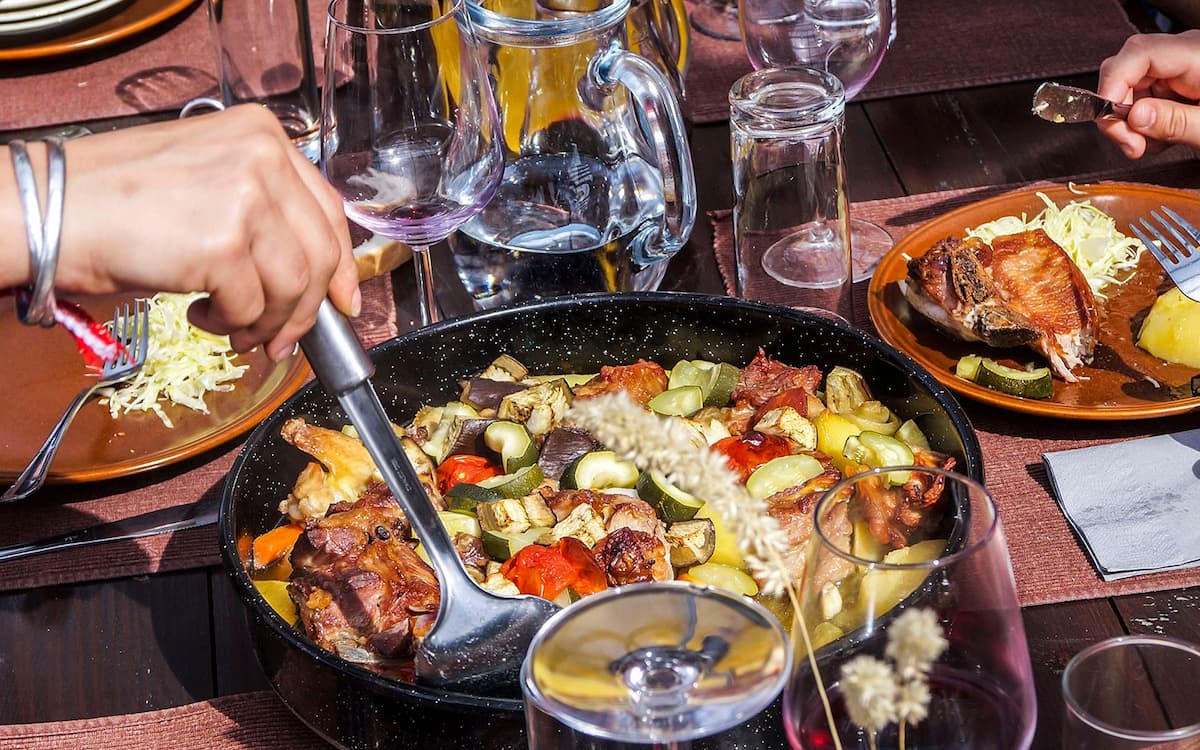
Culinary celebrations. October brings the island’s most delicious festival – Days of Brac Cuisine (October 15-25). This ten-day celebration showcases traditional island recipes across restaurants in multiple villages. I purchased a festival passport (150 kuna/€20) that included five vouchers for special festival dishes. At Konoba Tomić in Dračevica, I tried vitalac – a unique shepherd’s dish made from lamb offal wrapped in caul fat and roasted on an open fire. While it sounds intimidating, the flavors were surprisingly delicate and herbal. The festival also features cooking demonstrations where local grandmothers share recipes that have been passed down through generations.
Olive harvest. The olive harvest season in late October and early November offered my most immersive Brac experience. Through the “Meet the Locals” program organized by the Supetar Tourist Board (October 28-November 10), I joined a family in Škrip for their annual olive harvest. For 250 kuna (€33), I spent a day helping to collect olives using traditional methods – laying nets beneath the trees and gently raking the branches to release the fruit. The family shared stories of island life as we worked, followed by a home-cooked lunch featuring their previous year’s oil.
Day Trips from Brac
1. Split
Mainland magic. The ferry from Supetar to Split takes just 50 minutes, perfect for a day trip. If you’re wondering how to get to Brac or Split to Brac, this route is one of the easiest ways to explore both destinations. I caught the early morning boat, watching the sunrise paint the Adriatic gold. As Split’s skyline came into view – dominated by Diocletian’s Palace and St. Dominus Cathedral – I felt the excitement of arriving somewhere special.
Historical immersion. In Split, I headed straight for Diocletian’s Palace, one of the most fascinating places to visit in Croatia. Wandering through narrow marble streets, touching stones worn smooth over 1,700 years, felt like stepping back in time. The atmospheric basement halls, used in Game of Thrones, were particularly impressive. By mid-morning, I was sipping coffee on the Riva promenade, watching local life unfold against a backdrop of palm trees and azure waters.
Market treasures. Before returning, I explored Pazar (the green market) outside the palace walls. I purchased dried figs, local cheese, and rakija (fruit brandy) as souvenirs. A friendly vendor insisted I try her homemade cherry strudel while we chatted about island life. These spontaneous interactions often become my most cherished travel memories.
| Split Day Trip Details | |
|---|---|
| Journey Time | 50 minutes |
| Current Prices | Foot passenger: 4.25€ (low season), 6.24€ (high season)Car: 17.52€-25.06€ (depending on season) |
| First/Last Ferry | First from Supetar: 06:30 (Mon-Sat), 07:45 (Sun); Last from Split: 20:30 (low season), 22:30 (high season) |
| Must-See Attractions | Diocletian’s Palace, Riva Promenade, Cathedral of St. Dominus, Marjan Hill |
⭐ Best tours
- Split: Old Town and Diocletian Palace Walking Tour – Discover the largest coastal town in Croatia on a walking tour of Split. Follow a local guide to the top sights like the Golden Gate, Diocletian’s Palace, and the statue of Gregory of Nin.
- Split Food Tour: Discover Split One Bite At A Time – Without local knowledge, it can be tricky to know the most authentic local food choices to order off menus in Split; however, this Split small-group food tour is the perfect shortcut for travelers new to the city. Visit five eating establishments with a guide who tells you about each generously sized tasting along the way. Your guide also provides fun photo opportunities while telling a bit of Split’s history during this food experience.
2. Hvar Island
Island hopping. I took the direct catamaran from Bol to Hvar Town, operating daily in summer (June to September). The journey offered spectacular views of both the island of Brač and the island of Hvar. Arriving in Hvar’s harbor, with Venetian architecture climbing the hillside, was truly cinematic – one of the best things about visiting this destination in Croatia.
Lavender scents. After exploring Hvar Town and climbing to the Spanish Fortress, I joined a tour to the island’s interior. Near the village of Brusje, we visited lavender fields in full July bloom. Our guide demonstrated traditional harvesting techniques. I bought a lavender sachet from a local woman – a perfect aromatic souvenir.
Sunset splendor. Before returning, I enjoyed fresh grilled squid at a small konoba in Hvar Town. I then joined locals and visitors on the western harbor to watch the sunset silhouette the Pakleni Islands. This magical moment perfectly concluded my day on Croatia’s most glamorous island.
| Hvar Day Trip Details | |
|---|---|
| Journey Time | 50 minutes |
| Current Prices | 20€ (one way) |
| Schedule (Summer Only) | Departs Bol: 16:45 Arrives Hvar: 17:35 |
⭐ Best activities
- Tuk Tuk Sightseeing Tour of Hvar – This Tuk Tuk sightseeing tour offers you a chance to experience the attractions of the island Hvar in a different and unique way, with a vehicle that is an attraction itself
- Hvar Hidden Gems Small Group Half Day Tour with Lunch or Dinner – Experience Hvar like a local during this 4-hour ‘hidden gems’ excursion. See a side of this scenic island not often glimpsed by visitors as you explore the island’s rural interior, visit the “French Fortress” built by Napoleon’s troops, tour the 14th-century village of Velo Grablje, and enjoy an authentic Dalmatian meal (either lunch or dinner).
3. Solta Island
Hidden gem. I discovered a direct fast ferry from Milna (Brac) to Solta, operating April to October. The 30-minute journey revealed Solta’s pristine coastline and traditional stone houses – a glimpse of “how Croatian islands used to be.”
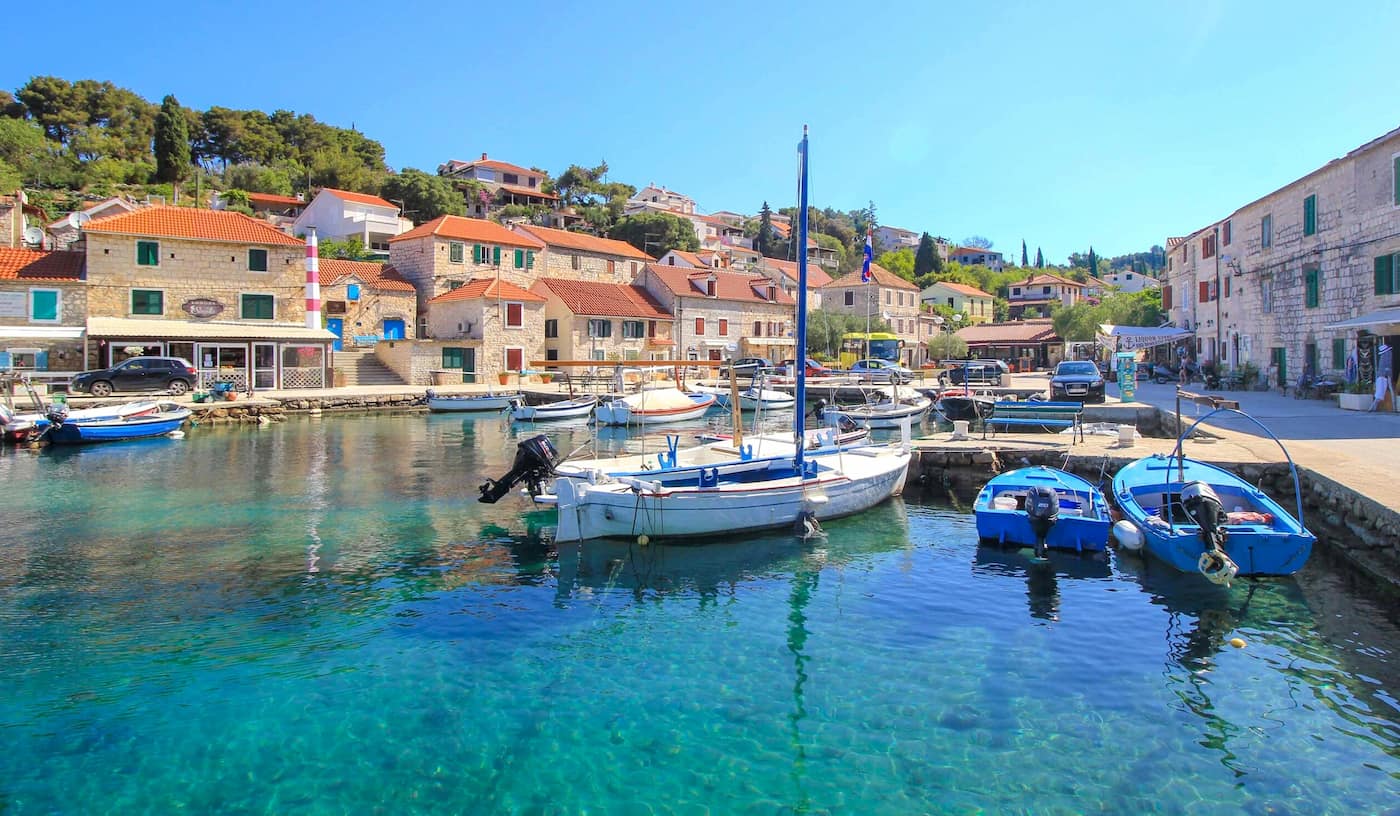
Olive traditions. In Grohote village, Solta’s center and one of its oldest settlements on the island, I toured a family-run olive oil farm where techniques have been passed down for generations. Solta’s microclimate produces exceptional oil that rivals Brac’s famous olive groves – making it worth adding this stop when exploring around Brac island.
Coastal tranquility. In Maslinica, a picturesque fishing village, I found nearly empty coves perfect for swimming. The village, built around a restored castle, offered a glimpse of authentic Dalmatian life. Watching the sunset over offshore islets from a harborside café, I felt I’d discovered a hidden treasure of the Adriatic.
| Solta Day Trip Details | |
|---|---|
| Journey Time | 30 minutes |
| Current Prices | 8-10€ (one way) |
❓ FAQ
How do I get to Brač Island?
You can take a ferry from Split or Makarska to Brač. The ferry from Split to Supetar is the most popular route, with frequent departures and a journey time of around 50 minutes. Car ferries are available if you plan to drive across the island.
What is the best time to visit Brač?
The best time to visit Brač is between May and September when the weather is warm, and the beaches are perfect for swimming. Spring and autumn are also great for hiking trails and exploring the island without crowds.
What are the must-see places on Brač Island?
Must-see spots include Zlatni Rat Beach in Bol, Vidova Gora (the highest peak in the Adriatic), Blaca Hermitage, and Supetar, the largest town on Brač. The island is also famous for its authentic charm and Brac stone used in Diocletian’s Palace in Split.
How do I get from Split to Brač?
Take a ferry from Split’s ferry port directly to Supetar on Brač. Ferries run multiple times a day, making it easy to include Brač in your Croatia travel plans.
Is Brač worth visiting for a day trip?
Absolutely! A day trip from Split to Brač allows you to explore some of its highlights, like Zlatni Rat Beach and Supetar. However, staying overnight lets you experience more of the island’s beauty and authentic atmosphere.
What are some of the best beaches on Brač Island?
Zlatni Rat Beach in Bol is one of the most beautiful beaches in Croatia. Other great options include Lovrečina Bay, Murvica Beach, and beaches around Sumartin on the eastern side of the island.
Can I hike on Brač?
Yes! Hiking trails like the path to Vidova Gora offer stunning views across the island and beyond. You can also explore coastal trails around Bol or hike through olive groves near Škrip, the oldest settlement on Brač.
What makes Brač unique among Croatia’s islands?
Brač is famous for its Brac stone, used in iconic buildings like Diocletian’s Palace in Split. It’s also home to Zlatni Rat Beach, authentic villages, and diverse landscapes that make it one of Croatia’s most unique destinations.
